








Equine


























Published since 2008
www.EliteEquestrianMagazine.com
info@EliteEquestrian.us
• Main Office, Ocala, Florida
PUBLISHER Bill Vander Brink Bill@EliteEquestrian.us
Riding a horse is not a gentle hobby, to be picked up and laid down like a game of solitaire. It is a grand passion.
Ralph Waldo Emerson
EDITORIAL STAFF
Editor-in-Chief: Noelle Vander Brink
Art & Antiques Editor: Dr. Lori Verderame
Equine Art Editor: Jeanne Chisholm

Fashion Editor: LA Sokolowski
Legal Editor: Avery S. Chapman,Esquire
CONTRIBUTING WRITERS
Stephany Fish Crossman
Alessandra Deerinck
Michelle Edgerton
Kat Fuqua
Patricia Hechter
Lynn Palm
Steven Schachter
Tom Scheve
Collier Wimmer
ADVERTISING
Advertising Sales, N.E.Region: Kathy Dress 610-420-9964 kdress@ptd.net

Advertising Sales, S.E. Region Karen Eagle 352-812-1142
Advertising Sales, National: Diane Holt 713-408-8114 diane@eliteequestrian.us






RSD Media Group


Elite Equestrian magazine has the best variety of editorial that readers find to be educa�onal as well as relevant.

Elite Equestrian’s hard copy distribu�on is na�onal and includes top rated shows and venues.
Elite Equestrian’s bi-monthly publica�on means YOUR AD IS CURRENT FOR 2 MONTHS, maximizing your investment.
Jennifer Ohlson Paws and Rewind Staff of Dr. Lori Diane Holt
Elite Equestrian offers discounts for mul�ple ad inser�ons.
Every issue is also produced as a digital on-line version, and every ad has a FREE HYPER LINK
Elite Equestrian’s Must Have feature gives adver�sers addi�onal promo�on and also hyper links to their web site. Ask for details.

Banner ads are available and browsers will find THOUSANDS of ar�cles on our web site to maximize viewing �me. Our web site averages 250,000 views/week.
Banner ads are FREE with an annual contract.
Reach out to us and let us customize a custom adver�sing package that suits your budget & needs.


info@EliteEquestrian.us

Elite Equestrian magazine ranked #5 equestrian magazine in the world, and so the #1 equestrian lifestyle magazine in the U.S. A. , by Feedspot Blog.

why you should advertise with us.

Fancy Jumper Squared Medallion
This design began as a Key Fob, and was so well received. I was asked to make it available in Sterling Silver and our Rose Bronze. The shape is a rectangle with open work allowing the jumper to jump through, and over two half round poles. The jumper has a snaffle bridle, and mar�ngale, buckled boots and a braided mane

www.tempidesignstudio.com
See our ad page 69

Hats With Equestrian Flair!

Riata Designs, where performance meets style. See our ad on page 25 riatadesigns.com
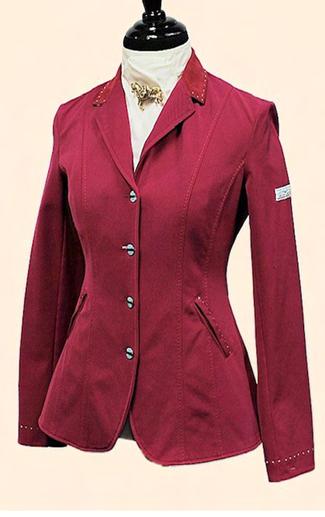
Da Brim Helmet Visors

DaBrim.com
See our ad on page 69
EQUINE CONSIGNMENTS!
Great selec�on of saddles, tack, boots,home items and more. Free trial on saddles. See our ad on page 69 www.GoodAppleEquine.com
EZ SIGNS
Free shipping!
1-800-640-8180
See our ad on page 33 www.EZSignsOnline.com
EQUINE CONSIGNMENTS!
Great selec�on of saddles, tack, boots, home ite on saddles. www.GoodAppleEquine
HUGE VARIETY OF COLLARS
Well constructed and durable.Classy, comfortable and strong. Leashes too!
Shown: CabachonSuede Turquoise collar. Available at AuburnDirect.com.
See our ad on page 27
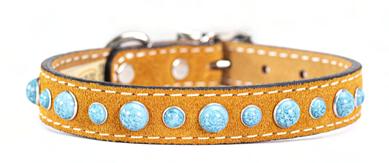




Years ago, SOURCE President and founder, Susan Domizi, competed her even�ng horse, Hull, a talented, generous-hearted horse-but a hard keeper with poor hoof condi�on. When the right micronutrients were added to his diet, he began to thrive. Hull became USCTA Reserve Horse of the Year in the U.S.; and so began the legend of SOURCE® micronutrients. Since 1975, SOURCE has helped thousands of horses like Hull not only achieve their poten�al, but flourish.
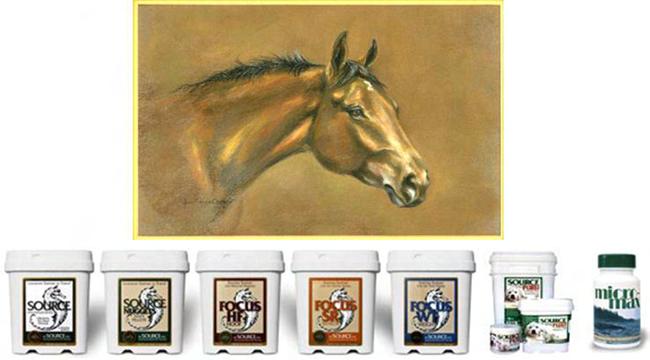
See our ad page 46 800-232-2365 www.4source.com
PASTURE VACUUMS


Collect manure, sawdust, wood shavings, leaves and rubbish. Also used for stalls, and cleaning out water troughs- just suck out the water, scrub and refill. See our ad page 49 www.pasturevacuums.com
Saddler’s Preserva�ve Protect and restore your valuable leather for years to come.

See our ad page 29 www.jmsaddler.com
EQUINE HEALTH PRODUCTS Liniment, Hoof Care, Hoof Soak
See our ad page 33 www.Vetericyn.com
Hoof Pro Protect and maintain your horse’s hooves in great condi�on!
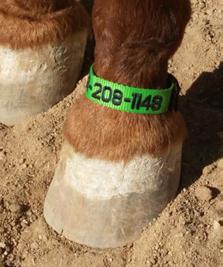


Created by a Master Farrier and Veterinarian.
EQUINE CONSIGNMENTS!
See our ad page 49 www.echoranchproducts.com
Great selec�on of saddle home ite on saddles. www.GoodAppleEquine
A must have for traveling and evacua�ons. Available for dogs and farm animals. First Aid kits and more.
See our ad on page27 www.EquestriSafe.com


mounts to cart or vehicle. ATV trailer cart assembly available. Proudly made in the USA by our team of cra�smen!
See our ad page 33 BigSprinkler.com
GUMBITS

100% FEI legal.
See our ad on page 71 www.GumBits.com
BEST ON-THE-GO Hay Feeding System! Less waste, be�er diges�on for your horse.

See our ad page 31 www.NibbleNet.com
“Derma��s Goes Away!” Vet Recommended, Owner Referred, Horse Approved Worldwide
See our ad on page 47 www.soxforhorses.com
See our ad for a coupon code!

Pyranha’s world famous oil-based and lanolin fly spray is now in a BOV, this new way to spray has a 360 degree con�nuous spray, does not contain any harmful propellants, has a 99% emptying rate and is 100% recyclable. All while containing the same great powerful pyrethrin formula�on that horse owners have come to know and trust.
See our ad on page 7 www.pyranhainc.com
Please tell our adver�sers you saw them in Elite Equestrian magazine!
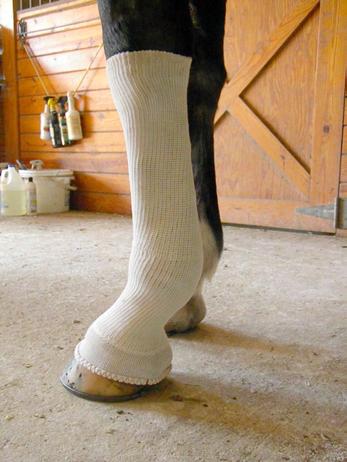
The #1 all-natural hot horse formula developed by a veterinarian. Helps promote calmness and focus in horses experiencing stress related to training, showing, racing, or travel. StressLess™ is non-herbal, all natural, and show safe. See our ad on page 2 HotHorseSupplement.com
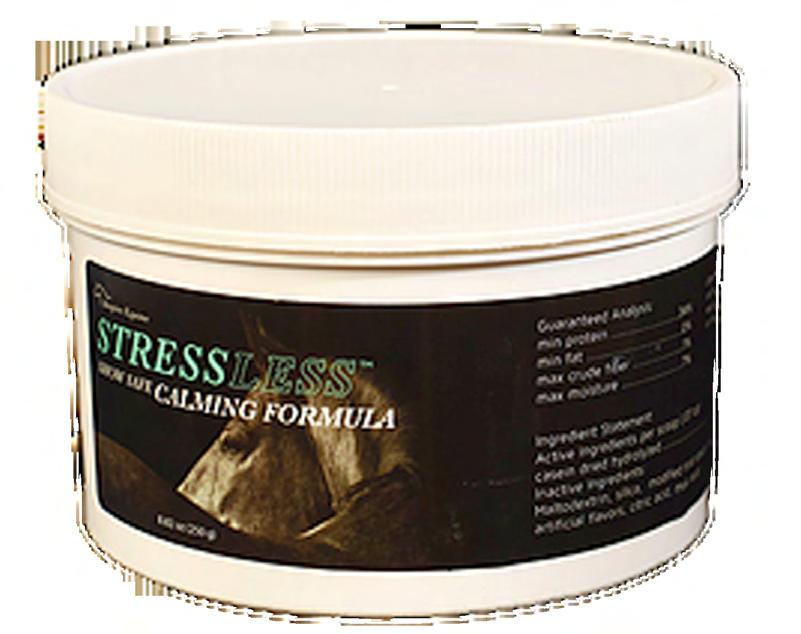


This season, British equestrian fashion clothing brand, Equetech combines the latest sports technical fabrics with innovative equestrian style and design for a collection that champions fashion with function.

Equetech Hideaway Padded Gilet

Equetech Ac�ve
Extreme Base Layer
See Next Page
This quilted vest was so popular with riders last season that Equetech has brought it back for summer! A beau�fully fla�ering vest incorpora�ng the perfect combina�on of comfort, design and func�on.
The quilted panels are designed to complement your silhoue�e, and it’s so lightweight barely know you have it on! Wear it on its own for those early morning show
days or as a cosy mid-layer to beat those autumn chills to come next season. Features include a luxury padded pillow collar, two zipped outer pockets with Equetech contrast zip pullers, toasty thermal pocket linings, curved back hem, premium faux down filling and metal Equetech badge to the front.
RRP: £83.95 XS - 3XL Mink/Gunmetal, Navy/Silver, Berry/Rose Gold
Equetech’s E-Tech Performance Socks are available this summer in their new stunning Peacock Blue colourway. These slimline equestrian socks feature focused support to the heels and arches with an�-microbial yarns with moisture-wicking proper�es.Protec�on panels to the heel and foot offer added comfort and are finished with the signature Equetech logo to the back. Sold in sets of two pairs.
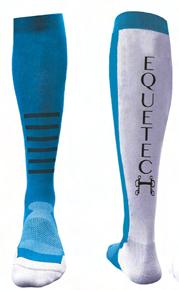
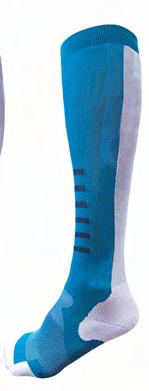
RRP: £16.95
Peacock Blue



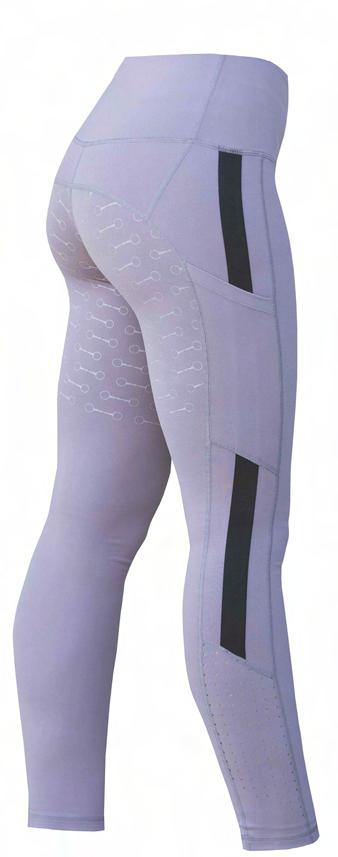
Signature by name and signature by design: These beau�ful Signature riding �ghts feature all the elements you’ve come to love in Equetech’s best-selling riding �ghts design; Technical 4-way stretch construc�on with compression and new for this season; Equetech contrast signature 3D sporty logo tape down the outer legs. Other details include a snaffle horse-bit ma� silicone grip seat, vented side panels to lower legs for airflow, ergonomic flat-lock seams to deliver a comfortable, chafe-free fit, wide comfort pull-on waistband with excellent shape reten�on and two thigh pockets (large enough for a smartphone).
Perfect for training and leisure ac�vi�es. With matching hat silks also available, these riding �ghts offer a beau�fully coordinated look in the saddle.

RRP: £59.95 Sizes: XS - 3XL Black, Lavender Grey
This gorgeous ac�ve extreme base layer embodies comfort and style! Featuring our unique raglan sleeves with mesh inserts that wrap around the body, this magnificent base layer offers the ul�mate style, comfort and breathability in the saddle to help you deliver your best performance! Other features include a zip front with their signature Equetech horse-bit puller and Equetech logo to the sleeve and scooped back hem. Styled in a super lightweight fabric that feels like silk to the skin and boasts rapid-drying and wicking proper�es, this garment is a must-have for summer riders!
RRP: £47.50
Sizes: XS - 3XL
Peacock Blue
Aqua-Shield Riding Tights

These gorgeous highwaisted casual and compe��on riding �ghts feature a prac�cal silicone full Seat and technical 4-way stretch construc�on, allowing for total freedom of movement without compromise. Complete with a waterresistant coa�ng, these suppor�ve riding �ghts feature belt loops to the waistband, flat-lock seams to deliver a comfortable chafefree fit, an Equetech logo to the back and two thigh pockets (large enough for a smartphone).
Perfect for training or compe��ons.
RRP: £69.95
XS -3XL
Navy, Grey, Beige, White
Equetech – leading the way in equestrian clothing innovation since 1992
www.equetech.com



If you’re on the fence about riding leggings, British equestrian sports luxe brand, Eqcouture has just launched some new generation breeches which marry all the styling of a classic pair of breeches with the contemporary design and comfort of riding tights.



The new style, Eqcouture Hybrid Breeches, are styled in a condensed close-knitted weave technical fabric which offers the supportive hug of a pair of breeches with the freedom of movement you’ll find in the brand’s range of riding leggings.
Styled along the lines of classic breeches, they feature traditional (faux) jean pockets to the front and back for the look and not the unnecessary bulk and two functional, deep phone pockets on both thighs. A generous wide higher waistband with belt loops and an embossed metal tag emulates the classic breeches look. The brand’s signature Eqcouture logo silicone seat adds a designer look, with sufficient grip in the saddle.

Finished with a pyramid stretch panel to the ankle for easy dressing and a slim profile, these Hybrid Breeches are enough to tempt any hard-core breeches fan to the riding legging’s dark side!
Colours: Black, Summer Navy & Beige
Sizes: XXS - XL
RRP: £ 69.99
www.eqcouture.co.uk
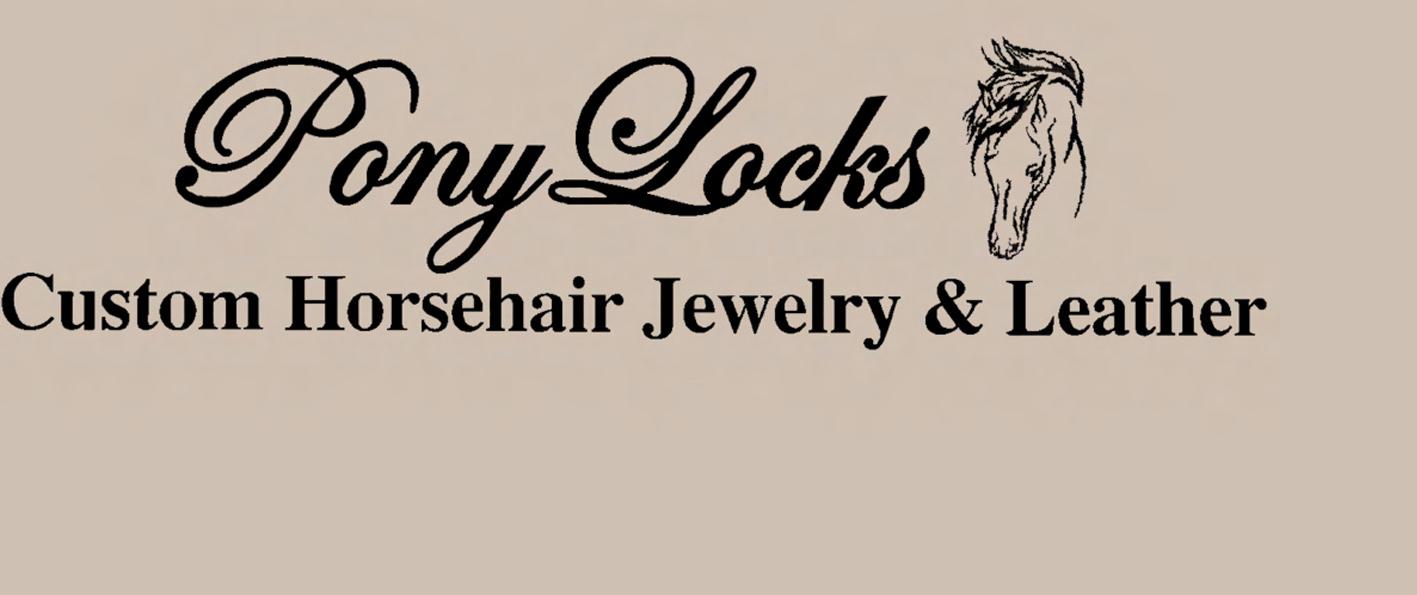



It has been 12 years since Jochen Schleese wrote ‘Suffering In Silence: The Saddle-Fit Link to Physical and Psychological Trauma in Horses,” and in the decade since, the Toronto saddle ergonomist and German cer�fiedmaster saddler has kept his promise to memorialize his Hanoverian even�ng partner, Pirat, re�red from compe��on a�er irreparable car�lage damage to his scapula, by allevia�ng suffering in other horses. “Although I was an appren�ce saddler, I had no clue that it was my saddle that caused him pain and lameness. I will never forget nor forgive myself,” Jochen says. “Because of Pirat, I want to help as many horses as possible avoid similar fates.” That’s why this two-�me featured guest on the Discovery Channel founded Schleese Saddlery Service and Saddlefit 4 Life® and teaches his pain-free philosophy worldwide at veterinary universi�es and equine trade shows in conjunc�on with the German Na�onal Riding School, Professional Trainers Verband, Ontario Equestrian Federa�on, and USDF. Jochen has changed the way saddles are made, sold and fi�ed all over the world, and the adaptability of their designs spans genders and disciplines, including an ultra-light racing saddle in 3-D development now because, he explains, uncomfortable young horses dri� as they run, and a dri�ing winner can be a disqualified one. Meet an empathe�c, scien�fic horseman (and fierce gin rummy player) whose book and YouTube channel will have you never looking at saddle fit -- or your horse’s back -- the same way again.

HERS: What do you remember about your first horse or pony?
HIS: My first competitive pony was named “Bubi” (which means ‘little boy’ in German but always gets a laugh in North America). He was a registered German Riding Pony, 14.1hh with a heart of gold. I competed with him in dressage, show jumping, and eventing. As I grew older, I rode against friends who had horses, but I still continued to win everything. My little boy beat the big boys! He was the horse on which I taught my wife, Sabine, to ride, as he was always reliable, and my little brother took him to the European Pony Eventing Championships! .
HERS: How old were you when you got your first paying job and what was it?
HIS: When I was twelve I helped a local farmer but instead of getting paid he allowed to me to board my horse at his barn. I first earned money when I began my apprenticeship to become a certified saddler, at age 16, with Passier.
HERS: What was your first big break in the horse world? HIS: I became the state eventing champion with my little pony, Bubi, riding against full-size horses. Then I qualified for the 1984 European Championships with my Hanoverian gelding Pirat. His unresolved lameness issues became the impetus for all that I developed over the years with Schleese saddles.

HERS: Best piece of advice you got early in your career?
HIS: Follow your heart and do whatever you do with passion. If you truly love what you do, you will never work another day in your life. My former master saddler and examiner, Max Hoepfner, made it clear that, despite being state champion, after my apprenticeship I still had much to learn. When I proudly showed my second award as state champion, for my master’s certification, to my master saddler and teacher at Passier, he congratulated me, and his advice was that I should only stop educating myself when I’m dead. I have taken that to heart and constantly surround myself with people who know more than I do, in life, but especially, in the equine industry.
HERS: If you had to work outside of horses what might you be doing?
HIS: My career choices were always based on anatomy and biomechanics. I likely would have gone into medicine in some form.
HERS: What’s your favorite quote and why?
HIS: My father was a physics and math teacher, and always drilled us to question, “Why?” I now paraphrase that to my staff, ‘People who know the How will always follow the people that know the Why.’ Don’t follow opinions blindly. Educate yourself. Make an informed decision based on facts, not hearsay.


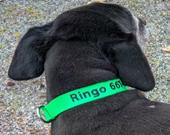
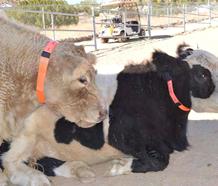


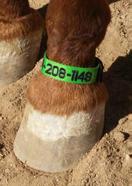
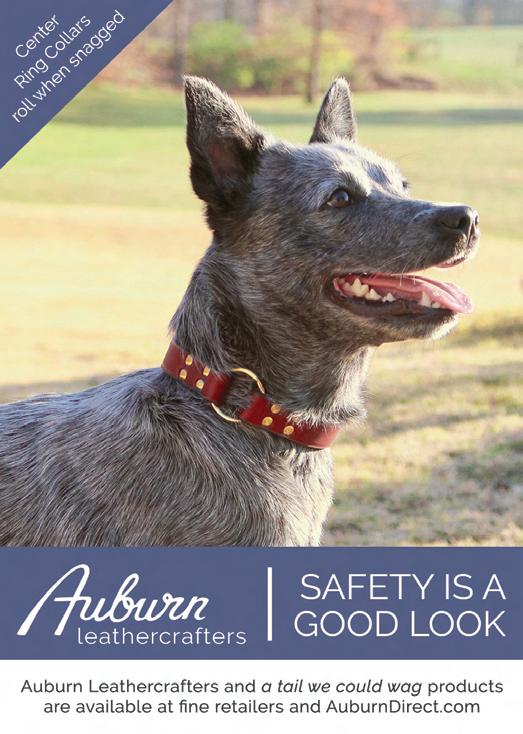


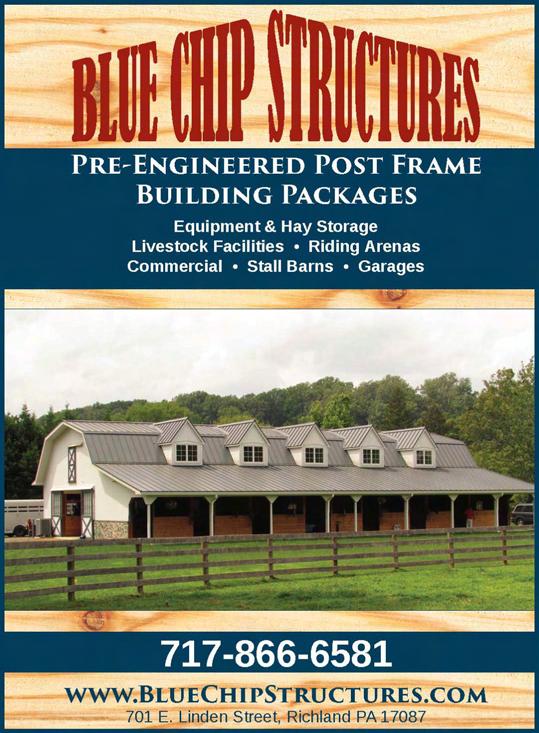
HERS: What has changed or evolved about saddle fit since you started?

HIS: Saddle fit has become a buzzword and has entered the riding consciousness. Through scientific research and anecdotal experiences, saddle fit has come full circle to how it was when horses were critical for survival. With the proliferation of so many saddle fitting “schools” come opinions serving to confuse the riding public as to what the actual issues and solutions can be. Demographics in the industry have changed, but manufacturing practices - with some exceptions – have not.. To follow my calling and honor the horse, I wrote Suffering In Silence, with many collaborators, which is used as a reference manual in equine professional trades and opened an online academy, SaddleFit4LifeAcademy.com, to give riders worldwide a chance to educate themselves based on facts, not opinions.
HERS: Where do you see saddle fit and Schleese in 10 years?


HIS: It is my dream that, down the road, Saddlefit 4 Life will be the basis for a common language of saddle fit. If English is the common language of business, and French the common language of diplomacy, then why could there not be a common language used in saddle fitting, based strictly on the anatomy of horse and rider, and keeping the physiology and biomechanics of both in mind? Ideally, there would be more of a consensus on proper saddle design and necessary fit. To continue to lead in innovation, with additional patents that bring the past into the future. To make products for riders that ensure horses are protected from long term back damage caused by poorly fitting saddles.
HERS: You can have dinner with three horsemen, past or present: Who’s invited and what’s on the menu?
HIS: Xenophon, Mark Todd, and Princess Anne. And I’ll tell you why the last has special meaning for me: I met her while working, after finishing my master’s certification, at Cliff Barnsby, as they were the royal supplier and Mark Phillips (her husband) was one of their test riders. I spoke no English at the time and was very nervous about meeting her. My boss said, just bow and say, “How do you do, your Royal Highness”. I practiced and practiced and, when the big day came, I did my best bow and intoned, “How do you do, your Royal Harness?” A year later, when I saw Captain Phillips again at an event just outside Toronto, let’s just say I needed no introduction! On the menu would be German white asparagus, with fresh peeled potatoes and hollandaise sauce. In Germany they say there are five seasons: summer, fall, winter, spring and… white asparagus time!
Learn more about how to get your free consultation and access to a free saddle fit video training guide from Schleese, ‘The Female Saddle Specialist,’ at Schleese.com.
Share suggestions for His & Her guests with award-winning equinsta L.A. Sokolowski at latheequinista@gmail.com.

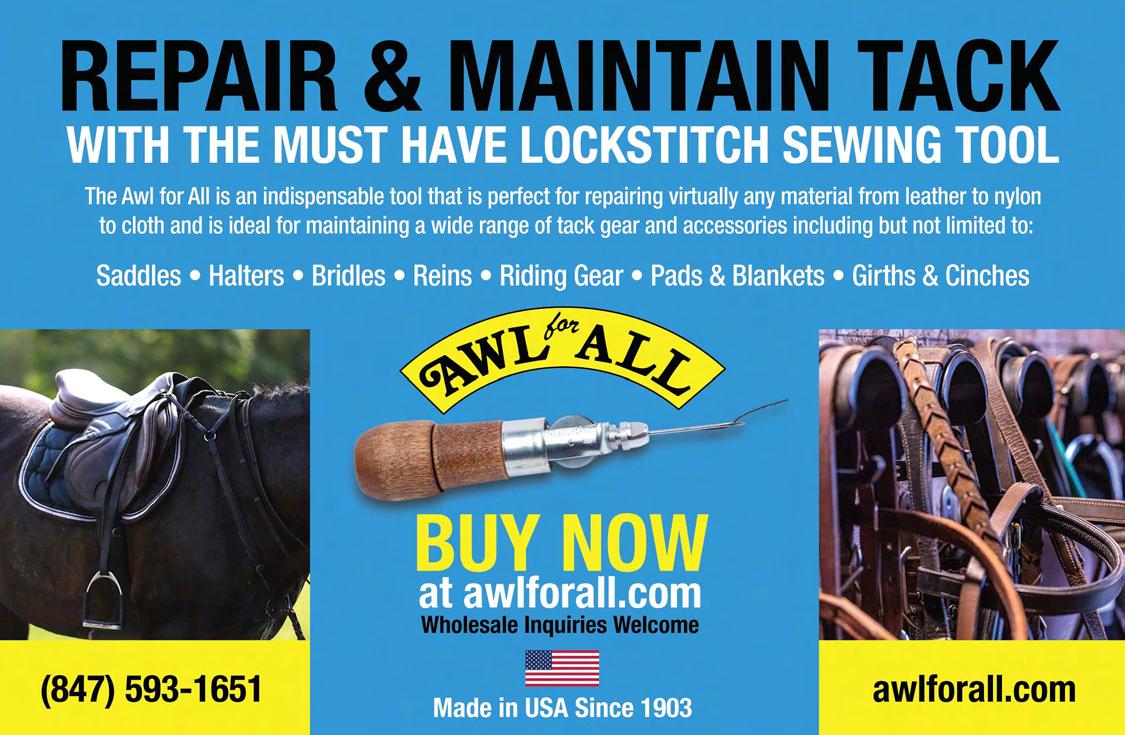


It’s time to enjoy the warmer weather! Look great and stay protected with these great finds! Be sure to tell our advertisers you saw their ad in Elite Equestrian magazine.
“I love this!
Not only does it have a great fragrance, it works great too! My horse’s face will be covered in flies and I apply the roll on and they are gone!”
Noelle Vander Brink Editor Elite EquestrianNature’s Botanicals are a premium natural Rosemary & Cedarwood essen�al oils for insect control. Repels flies, mosquitoes, midges, no see ums, and sandies. Customers have reported it also effec�vely repelling march flies, �cks, and ants.



Our natural insect repellent lo�on is made with a vegetable based emulsier. Unlike tradi�onal repellents the lo�on offers protec�on from insects while nourishing your skin. It also has a pleasing aroma, thanks to the Rosemary and Cedarwood essen�al oils. These products are safe for humans, dogs and horses. Available as a convenient spray or roll on. Cruelty-free, vegan friendly.
www.naturesbotanicals.us (360) 480-3255
Look great and keep cool while protec�ng yourself from the sun!
Riata Designs has a great selec�on of equestrian inspired hats to keep the sun off.

You’ll find beau�ful designs in all colors for short and long sleeve shirts, some with quarter zips, some bu�on down, compe��on shirts, dresses as well as breeches and hunt coats from Espoir® Equestrian. Shirts have 50 SPF protec�on and the fabric is light weight and excep�onally so�.
Our editor, Noelle Vander Brink shown posing at the World Equestrian Center in Ocala FL, enjoys spor�ng these elegant equestrian fashion pieces.

See Riata Designs ad on page 25 or visit riatadesigns.com Go to www.espoirequestrian.com, and check out their feature in the March/April issue of Elite Equestrian magazine on our web site at www.EliteEquestrianMagazine.com
This new book is a great, informa�ve guide to chiroprac�c care for animals. Dr. Bill Ormston, DVM, who has been a contributor to Elite Equestrian magazine for many years, explains about chiroprac�c care for your horse and why it makes sense.
He explains what chiroprac�c will treat and whom is qualified to perform these treatments. “Chiropractors believe that the power that made the body is the power that will allow the body to heal.”- page 105.
This is a great read to understand more about the benefits of chiroprac�c for your horse.
www.allcreatureseveryspine.com
at


 By Dr. Lori Verderame
By Dr. Lori Verderame
With the new Barbie movie coming to a theatre near you this summer, complete with a top-secret plot, collectors are ready to buy, sell, trade America’s favorite doll. Get ready because the sales will be active, and the prices won’t be cheap leading up to the premiere of Greta Gerwig’s film. The new Barbie movie is going to help drive market prices up for the popular vintage dolls and all the Barbie paraphernalia that goes along with them.
The Bild Lilli doll, the German fashion doll that sparked Barbie designer Ruth Handler’s inspiration for Barbie dolls in the first place, regularly sells for thousands of dollars on the open collectibles market. The German dolls had fashion outfits, makeup, and a well-known place in the history of doll collecting. I’ve appraised my fair share of Bild Lilli and Barbie dolls and Barbie accessories evaluating them all with high values depending on many factors.

Barbie will be the focus of the movie’s plot, no doubt, but her supporting cast of characters such as Ken, Midge, Allan, etc. will also have roles in the film as they did in the imaginations of children since Barbie’s debut on March 9, 1959, at the American Toy Fair in New York City.
In the Barbie-sphere, Barbie’s friends did not outshine Barbie. However, with collectors, Barbie’s friends are of interest. Ken was Barbie’s boyfriend and vintage examples of the male doll, and his accessories are collectible, but it is Barbie’s female friends that are most popular in the collectible doll market such as Skipper, PJ, Midge, and Francie, Barbie’s British, and very fashionable cousin. For instance, Midge was an interesting addition to Mattel’s Barbie doll line. Midge, Barbie’s best girlfriend early on arrived on the scene in 1963 and her boyfriend, Allan, appeared a year later in 1964. Barbie, Ken, Midge, and Allan would often double date.
Over the decades, Midge married, became pregnant, got cancelled and reintroduced. Midge’s boyfriend, Allan and later husband, as of 1991 when they wed, was featured much less often and less prominently. While Allan was Ken’s buddy, he was later unceremoniously omitted from the Barbie and friends group. Character backgrounds should play a prominent role in the new film. The foursome of Barbie, Ken, Midge, and Allan was not as popular as Barbie and Midge were independently. And, when Midge matured and had a magnetic baby bump that could be removed, controversy ensued. She didn’t share the same wholesome attraction as Barbie, wore less makeup, and wasn’t as fashionable when it came to clothing choices. As a result, Midge didn’t have the same prominence as Barbie either. Midge was discontinued in 1967 and PJ replaced her with blonde pigtails and a closer resemblance to Barbie. Midge returned in the late 1980s as part of the California Dream Barbie set. The 1980s Midge doll is a rare and sought after collectible doll today because she was a limited edition.

Barbie lovers liked her having a girlfriend, but collectors didn’t care who the girlfriend was, Midge or PJ. For the 60th anniversary, in March of 2023, Mattel reintroduced Midge. She featured her original and youthful freckled face, auburn hair, and she wore a two-piece creamsicle bathing suit. Midge did not have any babies or Allan in tow for her reintroduction.
The collectors who are ready to sell will have a good opportunity on the heels of the July 21 movie premiere. As a couple Midge and Allan don’t command the same values as Barbie and Ken, their more popular best friends. A well-dressed Midge doll in good condition from the 1960s would be worth $400 to $600 today. The best Allan doll example with an original box could command $300. On the other hand, a vintage Barbie doll regularly commands several hundreds to thousands of dollars from the most enthusiastic collectors.
Margot Robbie and Ryan Gosling, who will take on the roles of Barbie and Ken in the movie, promise to provide excitement to a collectors’ group that spans the globe. As these actors immortalize the beloved dolls, collectors get ready to reach into their pockets to buy new Barbie vintage objects or they’ll cash in on the opportunity that a big budget Hollywood feature will bring new money into a very slow doll market. Either way, it promises to be a cool summer with Barbie and the gang—both vintage in packages and on contemporary movie screens.



Canyon Madness Ranch, in northeastern New Mexico, is an extraordinary ranch oasis on 14,000 acres where the horses roam free and guests can savor a “back-in-time” vacation with 21st century luxuries.

Look for this fabulous feature with breathtaking photos in the July/August issue of Elite Equestrian!



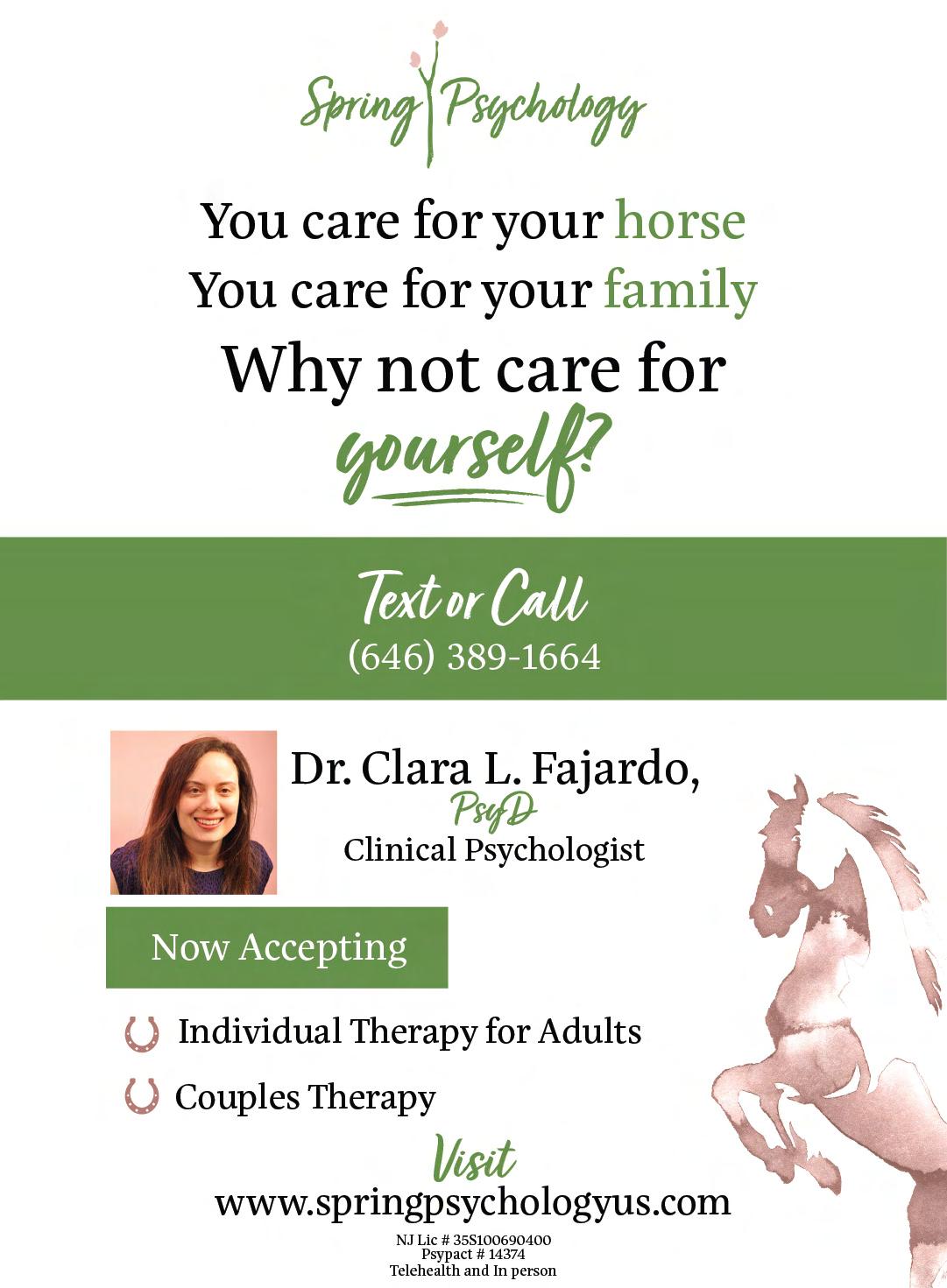


Kevin Babington enjoyed a renowned career as a beloved Grand Prix rider, and world-class Irish show jumper, winning countless horse shows and finishing fourth in the Irish Olympics. In the summer of 2019, he fell off his horse at the Hampton Classic, leaving him paralyzed from the chest down.
Now three years later, Kevin continues to work hard every single day—determined to not only walk again, but to get back on a horse again.
Helping him reach that goal is Samantha, a specially trained service dog from Canine Support Teams (CST). Samantha’s training began with volunteer puppy raiser Lindsay Brock, a photographer and journalist who is an equestrian herself, who raised Samantha from puppyhood to about 18 months.
CST Advanced Trainers provided a rigorous curriculum to teach Samantha specific commands to help Kevin in his everyday life, including turning on/off light switches, opening doors, signaling for help, and retrieving items. Perhaps most importantly, she provides companionship and support throughout his recovery, allowing Kevin to find independence once again.
It truly takes a village, and bringing Kevin and Samantha together was no exception – from the volunteer puppy raisers to the trainers and friends, board members, and supporters who provided the necessary supplies, veterinary care, food, and resources to support her journey to becoming a service dog.
“It is undoubtedly why I can keep going, because of the community, and the Kevin Babington Foundation, and continued support,” Kevin says. “I am overwhelmed by everyone’s generosity, and so grateful.”
Today, Samantha is a constant fixture by Kevin’s side, accompanying him to physical therapy, along the equestrian circuit, and in all day-to-day activities.


Kevin is a proud advocate for Canine Support Teams, proudly supporting the organization through the Silver Oak Jumper Tournament and the Kevin Babington Foundation. It is truly an ideal partnership as these organizations propel the love and independence that service dogs like Samantha can bring to their partners.
Founded in 1989 by Carol Roquemore, Canine Support Teams is a nonprofit organization which places an average
of 30 service dogs annually with people who are seeking social, emotional, and occupational independence. Carol has personally had five service dogs in her lifetime, and she knows firsthand the impact that an excellent service dog can have.
“It is rewarding to see what a dog can do to someone,” she says. “Kevin’s life is going to be improved thanks to Samantha, and that is the ultimate reward for us.”
CST’s great work is accomplished by a dedicated team of staff and volunteers. In addition to a small team of trainers and kennel managers, future service dogs are raised and socialized by volunteer Puppy Raisers and then trained by volunteer inmate trainers in CST’s Prison Pup program, a unique program piloted by CST in three correctional facilities in California and which serves as a model for other programs across the country today. Upon completion of training, CST service dogs have learned a combination of 70 unique commands and are prepared to receive certification to become a service dog. CST has about 300 active service dogs of various breeds working across the nation. For more information about Canine Support Teams, please visit caninesupportteams.org.







Foals are young equine individuals still in the process of learning how to behave, and relating with them can present difficulties.

The developmental stage of the life of a horse is fundamental for the part of the horse’s character that is formed through learning by experiencing, and caring about this stage to make it positive is a sure advantage for both individuals involved in the horsemanship.

In the natural state the mare is the first to interact with her foal and to teach him how to behave, then comes the stallion that often keeps away the other members of the herd. Later it is the foal from the previous year that approaches his mother and the newborn. When a foal is physically and socially ready to interact with other individuals, the mare let the other foals and adult members of the herd approach the foal.
When a horse is born in the domestic state it is still the mare that first interacts with the newborn, followed by the farm personnel. From here and on, the foal’s life is very different than what it would naturally be and the most disturbed factor is definitely the social aspect. Some people tried to solve this situation by substituting themselves to the mare in the first moments of life, so the foal would recognize the human as self. This intrusion often disturbs forever the natural mechanisms of development of the equine individual. It is like wiring an aircraft carrier with the circuits of a motorboat and pretend that it can serve its purpose.
Our approach to horsemanship is called Human Horse Sensing, and is based on a direct and spontaneous communication through movement, instincts and the natural senses of the horse, without the mediation of trained responses. The work done with a foal starts with a non-forcing and tack free approach, and the foals learn to respect the space with human beings and to behave properly in the presence of food. The foals learn to be haltered and lead properly without being forced, along with learning how to get groomed and to trust us when we pick up and clean their hooves without being contained. The goal is to raise

well balanced horses that will also know how to relate to people from the very beginning.
Whenever we had the possibility, we started working with mare and foal since birth, without constraints, but in a fenced space, big enough that they could safely get away from our vicinity if they felt they needed to do so. Our interaction works through space and reciprocal movements. Because of its nature, a horse would only let another trustworthy individual approach. If they try to avoid proximity to an individual and this one persists in his approach, the horse is more and more inclined to get away.
When we work with foals and mares, the mother’s presence and behavior is key in giving them a clue on how to interact with human beings. Throughout the weaning process we continue to work with the foal without the mare, sometimes staying outside of the fenced area where the foal is, until we have a clue that the foal understands the meaning of personal territory. The best way to develop good interaction with a horse is to always be aware of the horse’s behavior while we are in the same space and to interact with him without tack, keeping the horse away from us if he is “misbehaving” and only let him approach us if he is acting in an acceptable manner. Using a stick or a whip, and waving it around us, creating an area that we consider our territory, accomplishes keeping horses away from us.


In our experience establishing a harmonious relationship with the foal and his mother has helped the transition through the weaning phase, where the horse will be more in physical contact with human beings than with other horses.



It has been observed that in breeding horses there are great benefits to be gained from introducing foals to the human interaction in the first year of life, and letting them live in a herd while they grow up, so they can develop their social character and learn how to move and relate to other individuals in a way that is close to their natural state.
HH Sensing is dedicated to enhance horsemanship potential to support the interaction between human and horse, keeping their wellbeing in mind. With Human Horse Sensing solid horsemanship foundation, you will have the chance to be successful in any equestrian discipline and to take challenges that you would not imagine being possible even with good traditional training. With Human Horse Sensing, human being and horse work together freely with or without tack, through how they perceive the situations. Human and horse establish an active and dynamic dialogue, where you and your horse can exchange information or execute without being submissive, and you can become a leader of leaders. Our method can be learned through private sessions, workshops, online classes and clinics, and it is the subject of the book Human Horse Sensing Horsemanship that is available on Amazon. Web: www.hhsensing.com Email: hhsensing@icloud.com
Phone: +1 (760) 715 1554
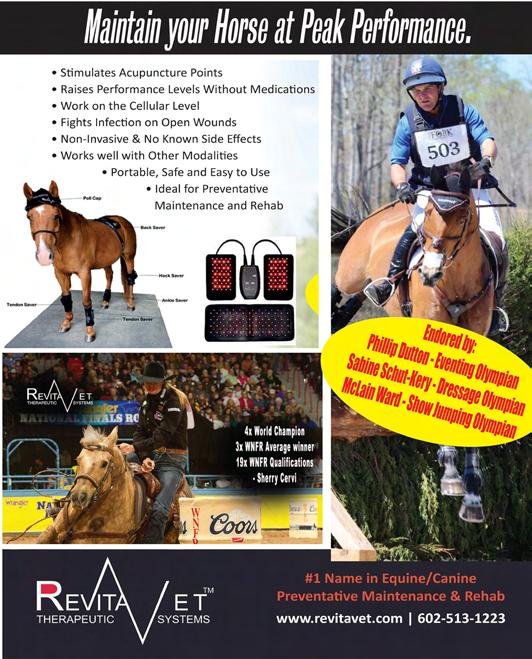

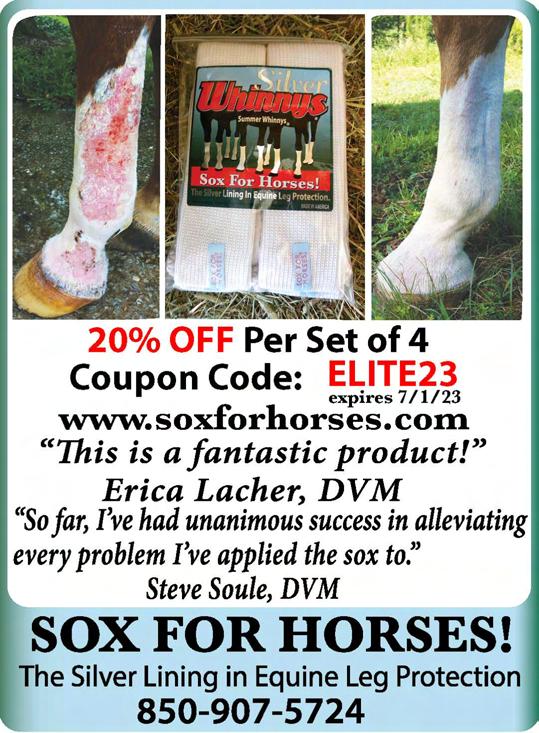
Your horse’s Animal Chiropractor is the only licensed health care professional dedicated to the detec�on, reduc�on, removal and preven�on of spinal subluxa�ons. Animal Chiroprac�c is the ul�mate health and wellness tool. Well-adjusted animals are less likely to have injuries, have healthier immune systems and will be able to make be�er decisions when asked to respond to commands. The reason a nervous system without interference is a nervous system that is able to func�on and due its job of controlling every system in the body efficiently.
Life begins with 2 cells that become 4 and then 4 become 8 and so on un�l birth. The heart is bea�ng, and the eyes are open, this miracle of development occurs perfectly unless there is interference. Animals benefit from chiroprac�c care before they are born by having a mother that has a nervous system free of the interference caused by subluxa�ons. Preconcep�on chiroprac�c care promotes op�mal uterine func�on. It prepares the female’s body to be strong, supple, and as balanced as possible to carry the maximum number of puppies to term. Adjustments will help increase the vitality of the sperm in the male. We recommend that all animals involved in a breeding program are adjusted on a rou�ne basis well before the breeding takes place.
When the mother is ge�ng ready to foal, the adjustment will allow her nervous system to relax and help the birthing process proceed as nature intended. It’s never too close to the delivery as the Chiroprac�c adjustment will help align the pelvis and make sure the birth canal is as large as possible. A well-toned uterus will have efficient contrac�ons and the best �me to adjust the newborn is as soon as they take a breath. The adjustment will ensure their nervous system is performing at op�mal levels. All foals should have their spine checked for subluxa�ons as soon as possible a�er birth, but especially those with condi�ons like contracted tendons, failure to nurse and even dummy foals.
The most important aspect of a subluxa�on is its effect on your horse’s nervous system. Birth is a very trauma�c experience for both momma and baby. These traumas may end up compromising the way their nervous system controls and regulates their body can lead to unhealthy consequences. Distorted communica�ons between the brain and the body can cause all kinds of health problems, not just sore backs, and necks.
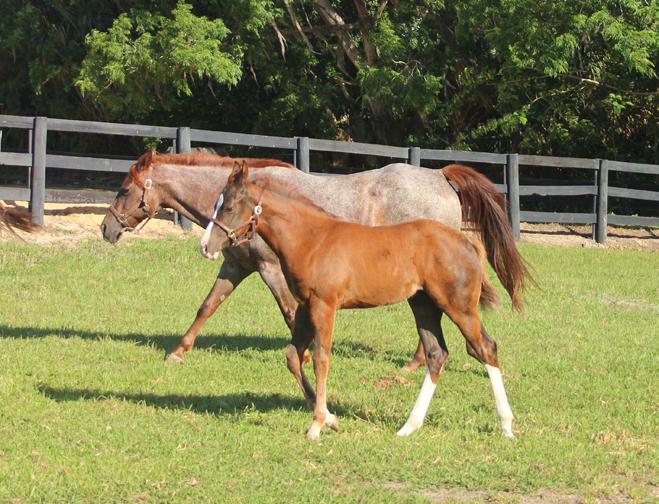
The intent of the Animal Chiroprac�c adjustment is reducing nervous system irrita�on so the adjustment will be very specific. They are focused, targeted, and allow healing to begin as soon as they are administered. It is this precision, combined with the purpose of reducing nervous system interference that has helped so many animals. Just about every animal can be adjusted. Newborns, young animals, adults, and even very senior animals. The Animal Chiropractor will tailor your pet’s care to their size, age and unique health problems.
Animal chiropractors don’t want to cure anything; the goal is to raise the level of func�oning of the body. Healthy bodies don’t get sick. This reduces your animal’s chances of ge�ng cancer, allergies, and other chronic diseases. The body consists of 25 to 30 quadrillion cells. Health is merely a condi�on in which those cells are working properly. The goal of animal chiroprac�c is to get diseased cells working properly again. Animal chiropractors don’t
focus on trea�ng all the diseases and sicknesses that your animals can get. They believe that they can help get the 25 to 30 quadrillion cells working properly again. Animal chiroprac�c is not like anything else; it is not a subs�tute or replacement for anything else. It is a totally different outlook on health based on the physiology of the body.
There is an inborn wisdom in living things that understands how to make insulin, adrenaline, and all the other chemicals that are necessary for living. That ability begins at concep�on and con�nues un�l the body dies if there is no interference. Every living thing has an inborn wisdom that enables it to survive through life. Animal chiropractors call this the innate intelligence that all creatures are born with—the intelligence that enables newborn babies to convert their food into walking, growing flesh and blood. This innate intelligence never makes mistakes. It knows exactly what it is doing all the �me. Animal chiroprac�c says let’s put health into the hands of the innate intelligence using the body instead of pu�ng it in the mind of educated experts using ar�ficial chemicals. Animal chiropractors check the body to see what is wrong with the controls. Health should be le� in the hands of the inner wisdom in all bodies. The brain and spinal cord are the first organs that are formed in the developing fetus. These organs then start to take over and control the rest of the development. The wisdom that controls the development of a fetus from 2 cells to 4, 8, 16, 32, 64, etc. un�l birth doesn’t stop at birth. There is an innate intelligence that controls growth and life all throughout life. New cells are made all the �me. Every 14 months, every vital organ is replaced except for the nervous system. The brain and spinal cord are the only organs that never get replaced. When the cells of the body get sick, they don’t need to be cured; the sick cells need to die and be replaced by healthy cells. If the new cells come in healthy, then the sickness is “cured.” If the sick cells are replaced by sick cells, then the body remains sick. The body must be crea�ng healthy cells for the body to stay healthy. The vast majority of pa�ents that become healthy while under an animal chiropractor’s care are rejects from tradi�onal medicine. Medicine couldn’t help them, and their owners came to the animal chiropractor out of despera�on. Animal chiroprac�c raises the level of resistance of the body to increase the chances of healthy cells. There are no incurable diseases if the body is working properly. The body does all of the healing once it is func�oning at op�mal levels. Animal chiroprac�c doesn’t cure any disease, but all animals are be�er off if the body is working a li�le be�er. Get your horses spines checked by a cer�fied animal chiropractor today.
Dirk works to ac�vate and enhance the body’s own way of healing itself. Manual techniques are applied to help restore op�mal func�on of the musculoskeletal system. By the use of manipula�on and adjustments, stretches and releases, and mobiliza�on techniques, it is an extremely beneficial non-invasive therapy for horses.








The health and wellbeing of our horses is always a something to keep in mind and at this moment in time many owners prefer to use non-invasive and drug free treatments to heal or rehabilitate their horses. Veterinarians are trying to comply with this tendency and research has been done about pain management care and rehabilitation that can also improve quality of life for horses. Aside from medications, there has been a development of non-invasive techniques to treat pain and inflammation and one of these is based on applying PEMF (Pulsed Electro Magnetic Field) to relieve pain and for other specific clinical situations including bone healing, wound healing, osteoarthritis, inflammation, and treatment of post-operative pain and edema. This therapy works by an electrical current driven through a coiled wire to generate a magnetic field. Various biologic effects come from applying the magnetic field, which produces small currents within a target tissue. This technique has demonstrated to be effective in resolving pathologies by promoting the flowing of the blood, that is the mean by which the oxygen, the nutrients, the hormones and the immune cells gets transported through an animal’s body.
In horses the heart is the pump that moves blood through arteries and veins through their body, but the blood flow is also influenced by the ac�on of the spleen and the hooves. In a horse the spleen is part of the immune system and works by filtering and elimina�ng damaged or diseased red and white blood cells from the blood. When a horse is not ac�ve the spleen can store a third of the horse’s blood and when a horse is in ac�on in few seconds 85% of the stored blood gets released and boosts the oxygen that reaches the muscles. Horse hooves have a func�on in pumping the blood back to the heart through the venous and lympha�c system. The distal part of the equine limbs has no muscles, just bones, car�lages, ligaments and tendons, but the frog area acts as a blood pump during mo�on, when the horse bears weight on the limb. The process that pushes the blood up the leg and back to the heart works through a network of veins that is compressed by the lateral car�lages and the coffin bone against the hoof capsule.
The heart is the organ that pumps blood through the arteries, but the flowing of the blood also relies on the addi�onal pumping ac�on of the micro-vessels, that reach the most remote parts of the body to distribute hormones, immune cells, and other signaling molecules, all fundamental for the metabolic processes.
Scien�fic studies have demonstrated that blood circula�on, which is very important for an individual’s well-being and physical performance, can be s�mulated and improved with bio-electromagne�c energy regula�on therapy. Good levels of health and fitness can be achieved by op�mizing the blood circula�on which adequately nourishes and removes metabolic waste products from the body’s cells, �ssues and organs.
Back pain and inflamma�on of the back is a common problem in equine athletes, and the possible causes include poor saddle fit, weak abdominal muscles, muscle hypertonicity, lameness, and bone problems.
The treatment of these problems can be difficult, but a therapeu�c device that works with a blanket that applies bio-electromagne�c energy regula�on produced significant clinical and biomechanical posi�ve effects in horses with back pain. Bio-electromagne�c energy regula�on therapy, works like PEMF, but u�lizes a low frequency and short phase dura�on, which results in a current generated within the �ssues without heat produc�on.
During the �me I work at Stenerson Ranch (www.stenersonranch .com) in Bonsall CA I recently witnessed this kind of treatment on two Mangalarga Marchador stallions, Batuque De Miami and Talisma’s Apache Do High Country, that were at their first �me being treated with the bio electro-magne�c regula-
�on blanket. I was very pleased to see how well the horses took the treatment, which has a residual effect that can last 12 to 18 hours. The device used on the horses is an FDA registered Animal Medical Device, as well as an FEI approved suppor�ve therapy, and uses a unique patented signal which is made by BEMER. (life.bemergoup.com/equine)
This blanket is very well constructed, easy to apply and can be adapted to horses of different sizes in order to reach the targeted areas with the bio electromagne�c energy. The blanket does not have a cord and the energy can be precisely regulated in terms of strength and dura�on of the treatment. Along with the blanket there are leg boots, that were adaptable too and applied to the front and to the hind limbs, to s�mulate the circula�on. The BEMER device can be stored into a carrying case to allow for easy handling.

A�er they were blanketed, both stallions assumed a very relaxed posture and were very peaceful while the blanket and the boots were working.
This device is being used also as a warm up or a cooling aid on horses that are trained for all different disciplines.
In light of these findings, along with regular exercise, rest and relaxa�on, grooming and a healthy diet, we can help our horses to heal, rehabilitate or perform by giving them a very relaxing and energizing treatment with a bio electro-magnetic energy regula�on therapeu�c session


The effects of a magne�c field on an living animal act according to the principles of physics, the species of the individual and the structure of the device used to produce the therapy. A magne�c field acts based on its capacity to reach the targeted area with ca�ons, par�cularly Ca 2+ ions, that are the main mediator for the bioeffects of a magne�c field. In order to control the chemical processes in biosystems the magne�c field uses the free radical mechanism and alters the intracellular water structure and proper�es.
Physical therapy using pulsing electro-magne�c field is an op�on to treat pain, to reduce inflamma�on, to accelerate the healing process and even to increase energy. PEMF therapy increases ATP produc�on in the mitochondria which results to boos�ng the energy in the animal body. Muscles are the heaviest consumers of ATP and oxygen, and the increase in microcircula�on along with improving oxygena�on of �ssues throughout the body definitely boosts the func�on of the muscles.
The therapeu�c results of applying the bio electro-magne�c energy regula�on are the increase in vascular blood filling and the accelera�on of capillary blood flow. These processes improve the delivery of nutrients to the organs and eliminate
metabolic products from them helping the body to fight sickness. The increase vascular and epithelial permeability that results from the magne�c field has the ability to fasten the absorp�on of medica�ons in the form of ointments.
The magne�c field eases pain by inhibi�ng the pain signals that are also electric en��es. Exposure to a magne�c field can also reduce inflamma�on by blocking prostaglandin synthesis, increasing microcircula�on, and releasing an�-inflammatory hormones into the blood. Edema is caused by an increase in blood viscosity, which can limit blood flow through the capillaries. It frequently results in poor capillary delivery of hormones, nutrients, and other biochemicals to �ssues. The processes by which PEMF therapy helps circula�on and diminishes the occurrence of medical issues are the blood vessel stretching, the reduc�on of edema, platelet adhesion, fibrinogen and inflamma�on. All of this results in augmenta�on of flexibility of the red blood cells, the main oxygen carriers, making it easier for them to pass through capillaries. Other benefits of PEMF are the decrease in viscosity of the blood that has an impact on circula�on by increasing blood flow at a faster rate and the increase of the blood flow to the bones that can produce higher bone density.
https://life.bemergroup.com/equine











Every lateral movement a horse makes involves abduction - the moving away from the midline of the body - and adduction - the moving toward the midline of the body - with his limbs. These movements directly involve more than 25 muscles in the neck, chest, shoulder, pelvis, hip, stifle, loin, hock and more.
An Equine Hanna Somatics® session with your horse begins with observing how your horse is standing without being posed. Where are his muscles and tendons directing his posture? Taking photos is a great way of having a reminder of how he is standing before you begin and to check with as you proceed.
How is your horse standing? What is his posture? Are his legs wider or narrower than his shoulders/hips? Does he toe in or out? Is he knock kneed, cow hocked or bowlegged? You will learn that what may have been previously thought to be part of your horse’s confirmation is actually his posture. Posture can be adjusted.
Use Initial Pick-ups to gently waken the body’s muscles and to prepare the mind/body neuropathways for change by performing Initial Pick-ups of all four limbs.Gently invite your horse to lift his leg as far as his comfort level allows. Pause Slowly return the foot to a fully weighted neutral location on the ground. The foot does not have to be directly under him, it can be to one side or in front or behind an imaginary plumb line from the point of his shoulder or hip. Repeat this process three times with all four legs.
Abduction is beneficial to begin with when the horse’s stance shows the limbs being pulled by the muscle anatomy away from his midline. Working with the most contracted muscles first, creates the ability of the lesser contracted muscles to be maneuvered in the opposing direction.
Stand on the left side of your horse, facing toward the tail. See photo 1 Using proper biomechanics for yourself, invite your horse to slowly lift his left fore foot off the ground. Remaining within his comfort zone, guide the leg from the shoulder slightly away from his body. Do not rotate or twist the limb at the shoulder or knee. Once you have reached the amount of movement your horse is comfortable with, pause, slowly return to his neutral place of where the leg hangs from his body then slowly return the foot to the ground allowing your horse to place his foot where it is comfortable for him. Repeat two additional times.
Moving to the hind limb, use the same technique as with the left forelimb by inviting your horse to move through the abduction of his left hindlimb. Take care not to rotate or twist his limb at the hip or hock. Repeat two additional times before moving to the right side of your horse. See photo 2
Adduction is used first when your horse’s posture has his limbs being pulled toward the midline. It is perfectly normal to have the front limbs require adduction first and his hind

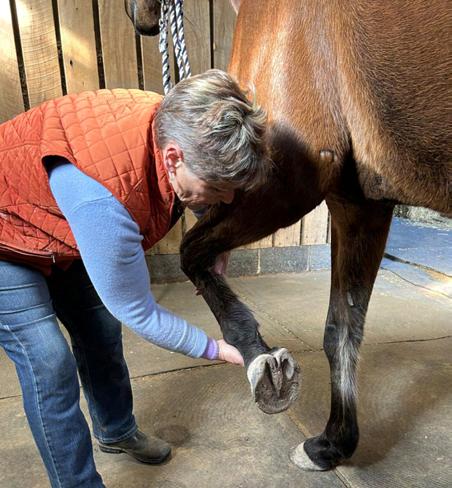
Abduction of the left forelimb. Take care to move the entire leg as one unit as the limb is gently moved away from the midline. This exercise is to relax muscles in the neck, chest and shoulder.
Abduction of the left hindlimb. As the hind limb is gently moved away from the body of the horse use care not to twist or rotate the joints. This exercise is to relax muscle contractions in the hip and hindquarters
limbs benefit from abduction first (or vice versa). Upon occasion it will be required to each of the forelimbs or hind limbs require abduction on one and adduction on the other.
Stand on the left side of your horse facing his tail, invite your horse to lift his foot off of the ground. Gently guide your horse’s leg toward his other forelimb. Depending where his muscle may be pulling his leg may go in front, in back or to the middle of his opposite leg. Or you may guide it the first time to the middle, the second lift to the front, and the final time to the back of his opposite leg during his adduction exercise. See photo 3
Repeat the adduction of the limbs with the three remaining legs, for three repetitions.
Adduction of the forelimb. Gently move the leg toward the opposite leg from the shoulder to the hoof. Take care not to twist or rotate any portion of the limb. The exercise is to release muscle tension in the neck, chest and shoulder.


Adduction of the hindlimb. Gently move the leg from the hip toward the opposite leg. The leg may move to the center, in front of, or behind the opposite leg. The intent is to release muscle contractions in the hip and hindquarters.
Perform Adduction exercises after Abduction movements, or vice versa, to maintain a balanced body. Once these exercises are complete, take additional photos to compare how your horse may have changed from the beginning of your session to the end of it.
These two movements are part of a full EHS session. For information about some of the additional movements please refer to previous articles beginning in May 2022 or on my website, www.HechterEquineMobility.com.
To purchase a video introduc�on of EHS please visit, www.HechterEquineMobility.com/video.
To learn more about Equine Hanna Soma�cs, and to find an equine educator near you, please visit www.EquineHannaSoma�cs.org.

Having a horse is a pleasure for us, therefore we should really treasure him and always keep in mind his well-being. When we want to ride, it is very important to learn to truly understand our horse in order to establish an effective communication and a good relationship with him.
In this moment in time, many are the approaches explored in order to meet the needs of the horse, and to bring horses closer to humans, but in most cases the interaction is based on training, the horse is still restrained with tack or physical barriers and deprived of expression and freedom of choice to participate in the action.
The stimuli
The horse is a live individual, not a machine! Through the senses the horse is always aware of it’s surroundings, perceives stimuli and always responds to them, even when they are as light as the touch of a fly or a blade of grass.
When horses have freedom of movement, we can observe how they really feel about a situation. The horse always responds to stimuli, and not just when it has been conditioned to do so. Indeed, the horse sometimes responds unexpectedly to stimuli that should arouse a conditioned response, adding to his action real emotions, such as aggression, depression, or anxiety. These emotions arise when the horse is placed under excessive pressure, or even forced to repeat an action over and over again, and this typically causes negative reactions from human beings.
To collaborate effectively with our horse, it is important to give him the opportunity to express himself freely about a situation so we can see how he feels about what we are doing together.

Human beings very often try to rigidly take a leading position towards the horse, without realizing that in nature this much sought-after position is not static over time, as we would like it to be. For the horse, the leadership state is linked to primordial survival, and is based on dynamic social relationships and environmental situations that change over time. In short, assuming the role of leader in a herd in its natural state also implies the responsibility of taking the herd to food, water and safety, which is maintaining a behavior appropriate to the position.
Another obstacle to true communication with the horse is the presence of both fixed (fences) and mobile constraints (tack), which limit his movement in space, an important part of his true expression. Without being able to perceive his silent expression, how do we know how the horse truly feels? But, are we really interested in how he feels or do we just want him to do what we want? Are we interested in seeing his expressions, or do we prefer to stick to his behavior with some prepackaged labels that only we like? The human being tamed the horse because he understood what enormous benefit could derive from it. Traditionally, in the relationship between man and horse, the horse is
expected to learn to respond to stimuli through conditioning, with positive or negative reinforcements, meeting the needs of the human being, which often have nothing immediately interesting for the horse. Indeed, sometimes even if involuntarily, in interacting with the horse the human being abuses the animal. What the human being would like is for the horse to learn certain actions, and the way in which we present them to him not only does not attract him, but often it does not activate in him the process sufficient to form the memory necessary for learning the behavior. This is true, even if, at times, the horse momentarily performs the action requested of him. The horse can live and thrive in this condition due to its extreme adaptability, not because it is an animal of low intelligence, but because his extreme ability to adapt to survive.
The horse spontaneously and instantly understands our silent ‘body language’ and if we consciously use our movement as a communication, we can learn how to communicate with him efficiently.
In my experience with thoroughbreds that came out of racing, I established a social relationship with the horse, a natural and very interesting context for him, before trying to teach him another sporting activity, which, on the other hand, is not always attractive to the horse. With racehorses, that are normally considered very difficult, these results are achieved by working with the greatest possible freedom, also respecting their expression, acknowledging their responses, and responding to their actions. From this experience I observed how horses learn, if they are genuinely motivated by curiosity. Another element that I observed is the possibility of working with the horse’s emotions, which


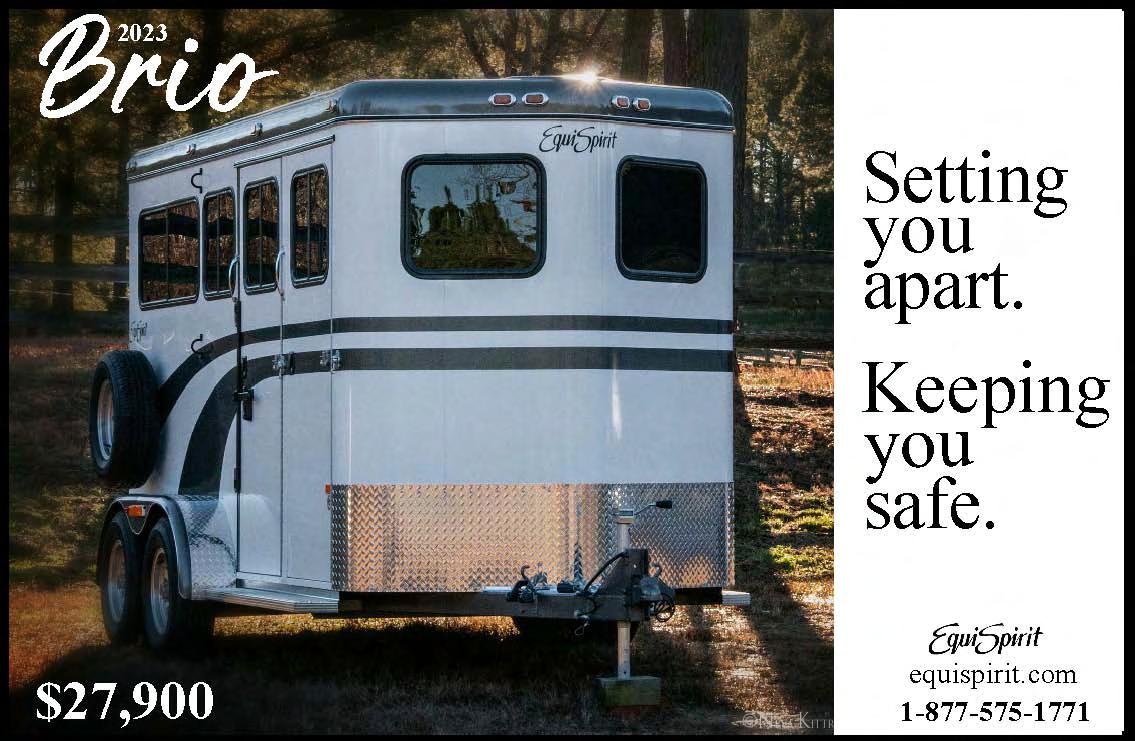

instead are always feared or carefully ignored, because the human being does not know how to contain or welcome them, and respond adequately. The relationship that is created by giving the horse the opportunity to freely express himself is truly unique and new and the possibilities that open up to work in collaboration between man and animal are endless.
We know that people forget what you said, people forget what you did, but they never forget how you made them feel. The same is true for horses too! I often find myself working in freedom of movement with horses I don’t know, explaining what I do ‘in words’ to people who are interested in understanding how to communicate with horses spontaneously. One day, during a course I held in Rome in 2009, I was working with a horse I just met, in a very large arena, right next to where they kept some cattle. It was the beginning of the course, and since I didn’t have a halter or a rope in my hands, everyone was wondering how I was going to work with the horse, which was far away, on the opposite side of the arena and seemed more interested in the cattle than in my presence. For those present it was strange that my first thought was not to go get the horse and put the halter on him. I knew that doing so would make the horse even more interested in the cattle in the adjacent paddock rather than in working with me. It would have been as if I had started talking about spurs and whips to those present who wanted to know how to work with horses in a natural way. I started walking towards the horse and spent a few moments close to him. Then I brought him a carrot and offered it to him while I was next to him and left soon after. In the time between my short visits, the horse had the opportunity to think about me and the brief moments we spent together. It took me a few times to convince him that my presence was something pleasant and so I was able to invite him to follow me with a wave of my hand to join the group of bystanders on the other side of the arena, leaving the side where the cattle was. It was the horse’s free choice, and since he didn’t have a halter or rope attached to me from the other end, he could also go back and stay close to the cattle. It was my responsibility to have a positive dialogue with him worthy of his attention and consideration. Someone was still surprised by the fact that I had nothing in my hand, and that I did not offer the horse other carrots, but above all that, he was with us and did not go back near the cattle. This state of affairs was what I wanted to achieve in the audience, and at this point I could start talking about the dialogue between man and horse and how to establish it correctly. Those who were present saw how important and effective it was to interact with horses without taking away their freedom of choice. The action had been unequivocal and had awakened everyone’s emotions, and that is when they really started to be able to understand the dialogue between man and horse!
Traditionally, the relationship between man and horse takes place according to a script established through training, which conditions the animal to respond in a predictable manner to certain stimuli, excluding its freedom of choice from the interaction. In the behavior of the horse, alongsidethe actions that have been conditioned in him, instincts are always involved, and other components that are beyond our control (his emotions!), But the difference

between these components is rarely highlighted. Understanding the relationship between freedom, instinct and horse behavior can help in trying to solve the many mysteries that escape us in the relationship between human and horse. To do this, we also need awareness and understand that species barriers must be overcome with facts, not by force or by denying that they exist. Freedom is a natural part of the horse’s essence and is the first thing that is limited when a human being approaches him. Instinct is that behavior that always and constantly manifests itself in the same way following the same stimulus.
The behavior of an individual has instinctive components that are constant for his species, others that are singular characteristics of him and that derive from his life experience and still others that are part of the emotional sphere and escape all control. The behavior of any individual changes constantly, even if, in the case of the horse, we men try to regulate a large part of his life experience. If we want to communicate with a horse, is it important to consider each horse an individual, to know its nature, and to allow the horse to express himself in the relationship we have with him. Horses are all different individuals and this is a fact that not even training and constraints have masked. Therefore, considering him an individual is now a universally accepted fact. In the matter of animal behavior, instincts are like the laws of chemistry and knowing them means having constant elements to understand the behavior of an individual, useful for overcoming the barriers between species and for communicating effectively. By starting to get a horse interested in interacting with us and letting him express freely, we can also come to face the parts that escape us in our relationship with the horse, such as his emotions.
Between mare and foal the very first subject of interaction is food, that is an essential need and that the foal receives it from his mare, who teaches him how to behave respectfully about it.
How to ‘interest’ a horse in a way that is natural to him? Everyone knows the trick of the sugar cube, but not many know how to cope with the implications of a hierarchical order that arise from offering food to the horse. Food is a subject that the horse understands without needing to be trained by conditioning. Generally giving food to a horse can put us in a position of subordination, which is far from that of a ‘friend’ that everyone wants to assume when they offer their horse a treat. Getting out of this misunderstanding and solving the enigma that our food offer presents
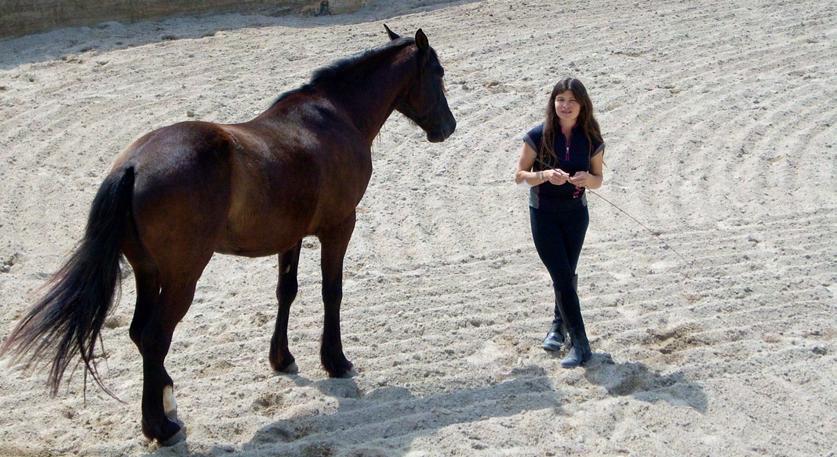
When horses have freedom of movement, we can observe how they really feel about a situation.
is not difficult, and we do so by respecting some social rules that the horse naturally respects. The teaching of good manners about food is one of the first topics to be handled in order to establish a bond of friendship, built on mutual respect with the horse. I have experienced that a good way to introduce food can be done in a fenced area, where the horse is at ease, in freedom of movement and without constraints. We can start by putting down some food so that the horse can see it, close to us, but outside the fence and out of reach of the horse. Carrots are ideal because they are easy to handle and can be given to the horse at will. When he chooses to approach us, we should touch him, let him stay close to us for a few moments, then ask him to move away. If he walks away and doesn’t try to return to us, we should bring him a carrot. When asking the horse to move away we should make the action of taking space towards the area occupied by the horse, aiming the movement at the ground, and not towards the horse’s body. Then, go back to the point of the fence near the food and wait, when the horse returns, stroke it and repeat the actions. When the horse shows to understand what is happening, hold the carrot in your hand and wait for him to return. When he is approaching, ask him to stop, moving towards him as if you want to send him away from the area in question. If he stops, give him the carrot. If he doesn’t stop, put the carrot back on the other side of the fence and start over. In a short time, the horse will understand that the carrot is yours and it is a gift you offer him, not something that he is taking away from you. The horse must eat the carrot gently, ceasing to eat from your hand if you ask. If he does not behave like this, start the lesson again from the beginning, without reprimanding the horse. When he understands that the carrot is a gift, and you see a change in his disposition and behavior in the presence of food, you can begin to use it in your interactions. You can also repeat the lesson if your horse loses enthusiasm, patience, kindness or respect. Between human and horse, details from each side are an important matter.




Accredited RWYM coach, Stephany Fish Crossman reviews a rider to help the team improve their ride!
This issue I am sharing a couple of photos from a clinic I did in Jupiter Florida. Kylie was brave enough to let us use her pictures for some learning and growing, Thanks Kylie!

In our first picture you can see a lot of good stuff already going on with Kylie - her thigh lies nicely into the thigh block, her basic shoulder-hip-ankle bone alignment is good, and she is a fairly good match with the front and the back of her. Kylie said that she had a difficulty with her half passes, that she wasn’t able to do them as well as some of her other lateral work. Half passes aren’t seen un�l 3rd level for a reason - they are trickier than they appear! In order to get a quality half pass, you need to be able to keep the horse moving FORWARD in the direc�on of bend, which is part of what adds to the level of difficulty of the movement. Looking at Kylie, I could see right away where we could make an improvement to help with this. I did not guarantee we would work on the half passes themselves during our 2 days together, but that I would give her the pieces to take home to improve them over �me.
Another piece that needs to be taken into considera�on is Kylie’s mount. Her beloved Tabu is a wonderful, kind PRE, but he mirrors Kylie’s body (don’t they all?!?) and THAT is where the problem starts. Or shall we say the fun?
If you look closely at the back of Kylie, you will see that she has a bit of a hollow where her pants meet her shirt. In response to this slight hollow, in the front of her, her bellybu�on is out - in horse terms, she is travelling with her back down! If you can imagine that this place, where her pants meet her shirt, is the same as just behind the saddle on the horse, you can see that her body isn’t keeping the horse a�ached between his back third and his middle third. He is not “over” his back, his hindquarters are “merely a�ached”. You can get by for a �me with this level of “merely a�ached”, but when you add the difficulty of a movement like half pass, you find progress comes to a sliding stop! Incidentally, Kylie also has problems with the changes being clean - another sign of a “merely a�ached” hind end!
We brought Kylie’s collarbone forward, so it aligned with her sternum and brought her bellybu�on back so the pelvis was level. Kylie’s words were “I feel like a shrimp!” so we con�nued to ask her if she felt like a shrimp, lol! The rider’s feel is more important than the words being specific - feeling like a shrimp gave me the posi�oning I wanted from her body, so away we went!

You can see in the second picture that Kylie doesn’t look anything like a shrimp, but instead looks engaged, strong and ready to ride! As we worked throughout the 2 days, we went through various gaits and movements, always checking in to see if she had “LOST IT” or she s�ll “GOT IT” with her shrimpyness. What was so cool was the correla�on with the horse - when Kylie “had” it, she was able to maintain Tabu’s forward and his organiza�on. When she “lost it”, it was easy to see that he got less engaged, and the movements suffered. Even in her canter work, we were able to create clean changes by focusing on “are you a shrimp” all the way across the diagonal. Ques�ons? Comments? Thanks again to Kylie for le�ng us use her pictures, and a big CONGRATS to her on her 64+% at 3-3 with Tabu at her show!!
Ques�ons? Comments? Please reach out to Stephany Fish Crossman, Serendipity Dressage 561-262-0807 www.serendipitydressage.net
Clinics are a great way to learn specific informa�on from the best in the industry. The targeted lesson is a sort of boot camp to learn specific skills that pertain to you and your horse. Given that freestyle planning and designing can be challenging, working with a professional is a fabulous way to create a successful program that works for you and your horse.
Our freestyle columnist, Collier Wimmer, is an excep�onal clinician who enjoys sharing her exper�se to help dressage riders plan this exci�ng new level of their training.


Collier explains, “When I think about dressage freestyles, I think of stories. It’s a visual story built by taking two of your base senses (seeing and hearing) and combining them into one. It’s an immersive story that you (as a rider, a judge, a spectator) can be a part of.
I’m inspired by stories, I’m inspired by music that moves, I’m inspired by the horses that partner with us, and I’m inspired by taking risks and constantly learning.”
Collier has helped me with Chistoso WC build a music freestyle. Chistoso has par�cipated two years in a row in selec�ng his music and building a well designed dressage test suitable for his breed. The first year we had fun exploring music suitable for Chistoso’s gaits. As a PRE, I wanted something that accented his lberian heritage, so Collier played several songs, and Chistoso picked his song. A year later he s�ll enjoys our music. With the new musical freestyle requirements, I appreciate the specially designed test. We are ready to to show off our dance.
Martha Steward and Chistoso WC
Recently I par�cipated in Ms. Collier’s Three Wishes Freestyle Clinic. She is incredibly nice, helpful, and talented at crea�ng dressage freestyles. She is amazing at choosing wonderful pieces of music and crea�ng choreography that best suits the horse and rider. She makes sure that your freestyle is something special to both the rider and horse. Ms. Collier believes in teamwork and makes sure that everyone is involved. I have never been more sa�sfied working with someone, like I have working with Ms. Collier.
Aislin Falasco, FEI JuniorCollier is absolutely amazing, as she combines the knowledge of dressage with her dance background. Her help in finding the right music for my horse and crea�ng an amazing choreography is so valued, and has made crea�ng a freestyle so easy. I cannot wait to try my freestyle at a show!
Petra Wilder, a USDF Bronze, Silver and Gold Medalist ( in photograph, above )
Facebook: https://www.facebook.com/ThreeWishesFreestyles Website: https://www.threewishesfreestyles.com

Palm Partnership Training™
Building a Partnership with your Horse
 Story and Photos By Lynn Palm
Story and Photos By Lynn Palm
Ground driving is also called Long Lining. Ground driving is a very good training technique for young horses to learn how to turn right and left, stop, and back. This exercise provides a great variety of training for any age of horse or rider. 1 2 3
For the human part of this partnership, ground driving works on your coordination. It provides a focus on what you’re doing with your arms, adjusting your reins and keeping them organized, your foot fall to stay in line with the horse, or your foot fall to stay inward on a curving line. You learn how to flex the horse’s head inward so you can just see his eye.


The outside rein is longer to keep the horse straight and aligned. You also turn the horse by using the outside rein to move him away from the pressure of the rein. This is the same as under saddle, as a horse will turn with the inside rein. However, if you do this at the trot and especially the canter, you will have a poor turn and your horse will not be straight and balanced.
This exercise is also an excellent way to learn whether your horse is straight or not. You can see the top line and his spine. You can also see his head as well as the foot fall. When a horse is straight, the right hind steps into the right front foot print, and the same with the left. When you observe this and understand it on the ground, it allows you to learn it under saddle when you can’t actually see it. For the horse, this exercise is stress-free, and you can do all kinds of figure patterns as in Dressage tests by initially using these patterns in ground driving.

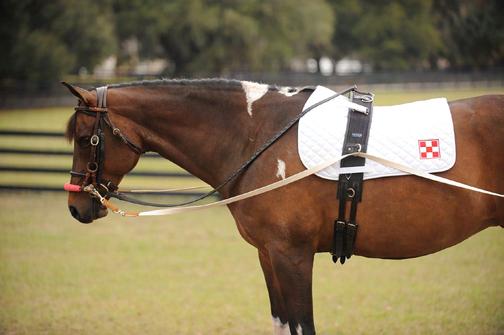
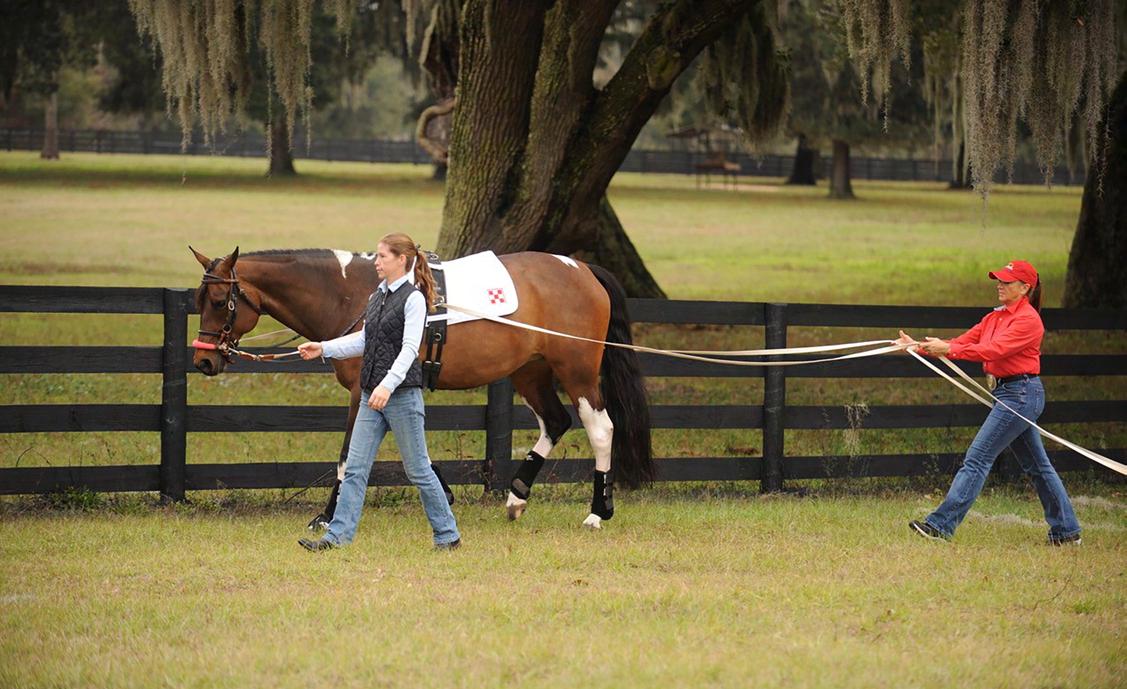


When you accomplish good, controlled responses with the walk, you can move to the trot work and then to the canter. Remember the trot is the best gait for developing the horse’s muscles and strengthening the joints. It’s a two-beat gait and you can develop the horse’s weaker side to be as strong and supple as the strong side. Remember, horses are right- or left-handed!
I also have a training DVD on ground driving. If you’ve never done ground driving before it’s an excellent way to understand the techniques, especially your positioning on the ground for good control. It’s a lot of fun and horses like it!
A �re blowout on your horse trailer �re is undoubtedly a hair-raising experience. But once over the shock, you’ll feel a whole lot be�er knowing you are wellprepared and equipped to handle it.
Heat is the true killer of tires. Unless the air pressure is at the maximum psi, they will heat up from excessive flexing and are apt to explode. It’s a great reason to check the air pressure before leaving and returning from your destination. An under-inflated tire also lowers a tire’s weight rating, which is how much weight each tire can carry (load range). Add the heat from an under-inflated tire to the decreased load range, and you’re asking for trouble. Since the exact size tires in different brands have different weight ratings, it’s wise to know what it is. You can find it stamped on the tire’s sidewall as a letter, often after the word “load range.”. Then search for a tire chart online and match the letter to the weight rating.
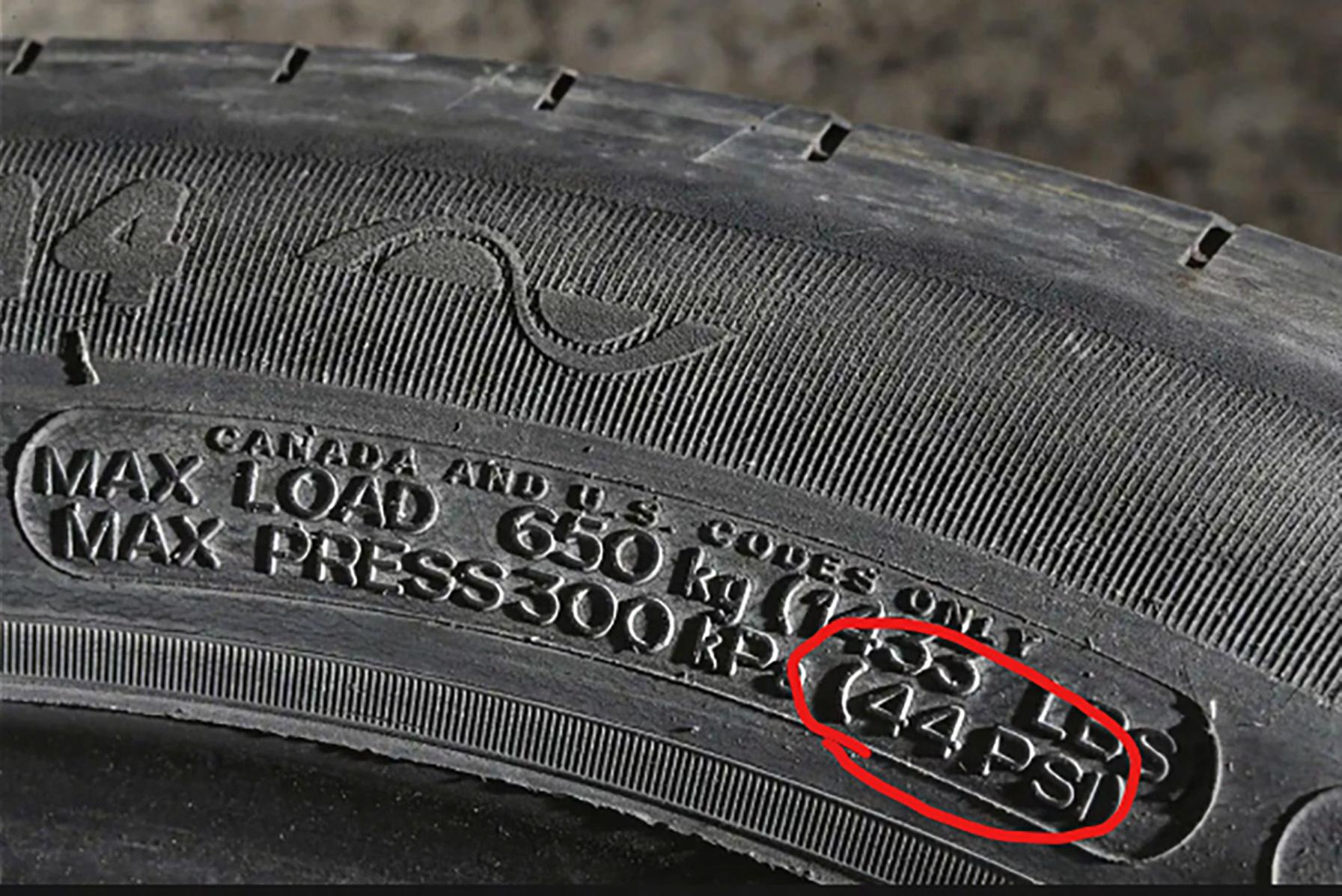
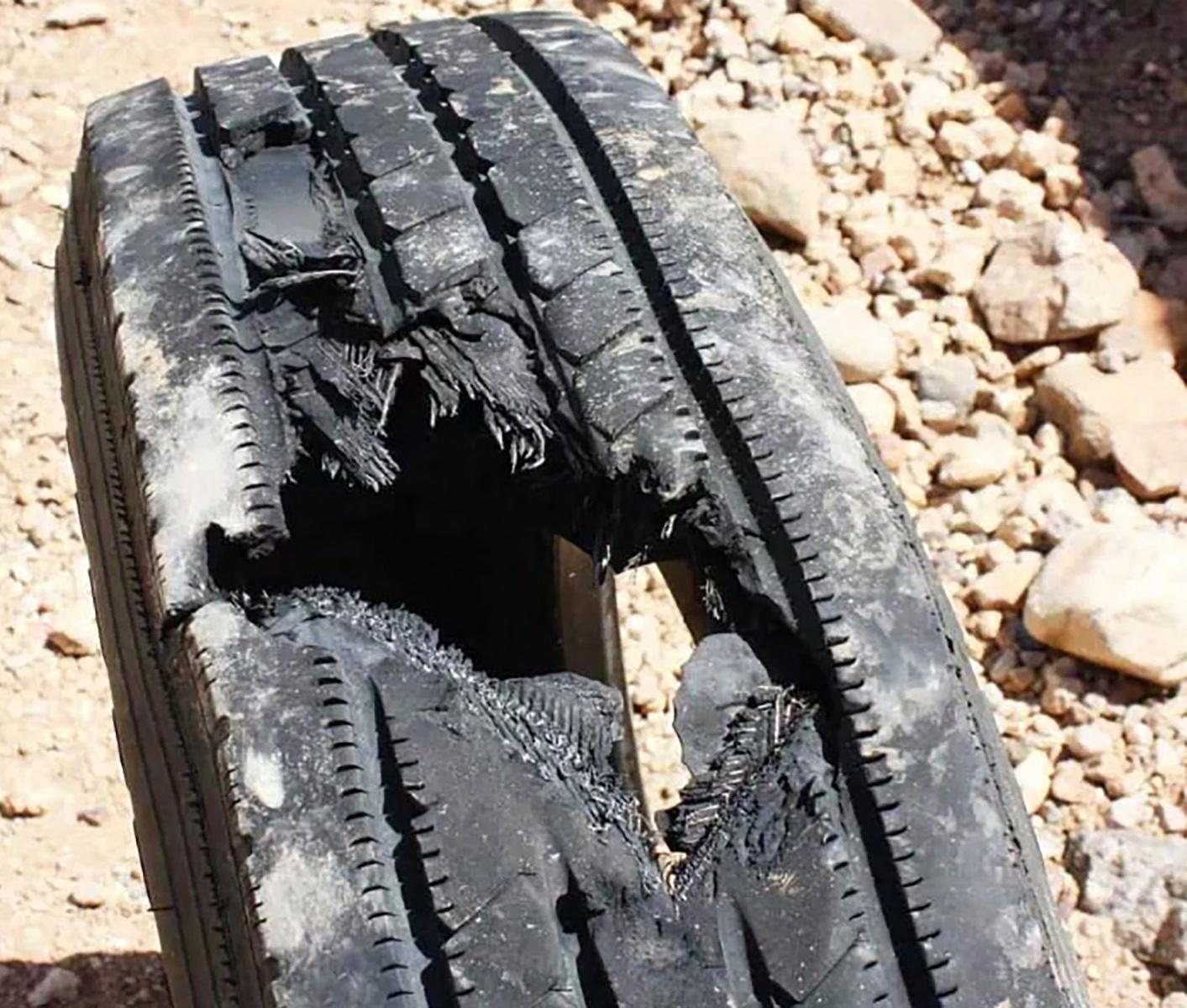
Another enemy of tires is age. Like us, parts of it start to deteriorate. Glues dry, rubber deteriorates, dry rot sets in…so don’t be fooled by thinking that if a tire looks good, it is good. Better to be safe than sorry. If they are over six years old, it’s time to replace them. Also, like us, tires don’t have an expiration date. However, they have a birthdate, a build date is stamped on the sidewall. It’s a four-digit number stating the week and year it came into existence. If you are buying new tires, ask the seller the build date before giving him any money. Tires age the same, sitting on a distributor shelf as on your trailer.
I’m often surprised at how few trailer owners know that trailer tires have speed limits, and exceeding the speed limit also creates heat. It’s helpful to know the speed limit so you can stay under it. You can find this information online or look for a letter at the end of the tire description and match it to a tire chart, also found online. Most trailer tires are sixty-five mph, but some, such as Goodyear Endurance, are in the eighties. I highly recommend investing in tires with higher speed limits eliminating the worry of having to watch your speed on freeways.


Speed

Limit
and
HEAT
Trailer manufacturing purchasing agents tend to shop for the best deals on aftermarket products. That includes tires, so your brand-new trailer may not have included the best tires. If not, consider replacing them or using them as a bargaining tool when buying it.

Unfortunately, you can never completely eliminate the risk of having a blowout or a flat, but you can reduce the possibility. However, if you are hauling horses, wouldn’t you feel better knowing how to deal with it if you do?

Lisa Goldman-Smolen and Ivaro N!
“This was my first big win” declared an ecsta�c Lisa Goldman-Smolen.
“My goal was to go double clear!”




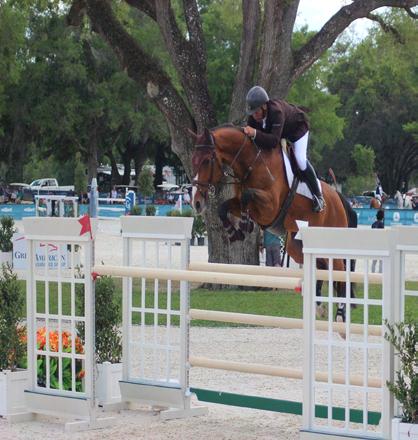
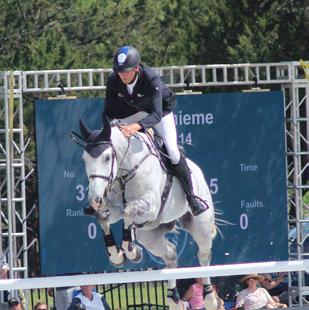
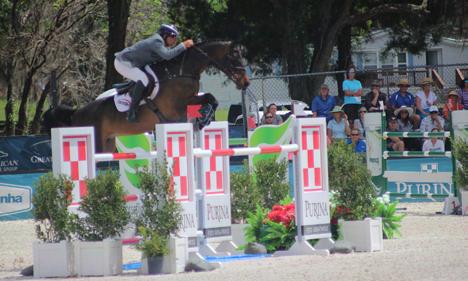

Course Designer Marinan Azevedo, from Brazil, said that designing this course, being in a different arena, was very challenging. Only four of the forty competitors made it into the jump off: Sco� Keach- 2nd place, Aaron Vale- 3rd place and Andre Thieme- 4th place.

Joe Norick, HITS Chief Customer Officer, said he is excited about HITS 2023! There will be new foo�ng and new arenas including a Hunter Derby ring. “We want to be a proud supporter of our compe�tors.”


Aaron Vale and Obi Wan


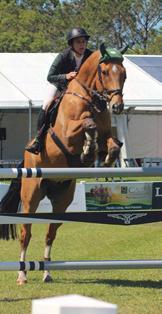


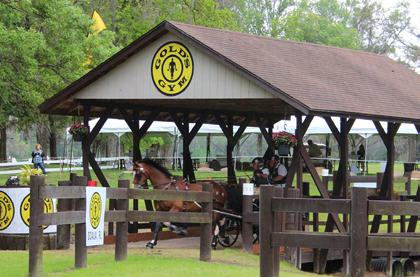










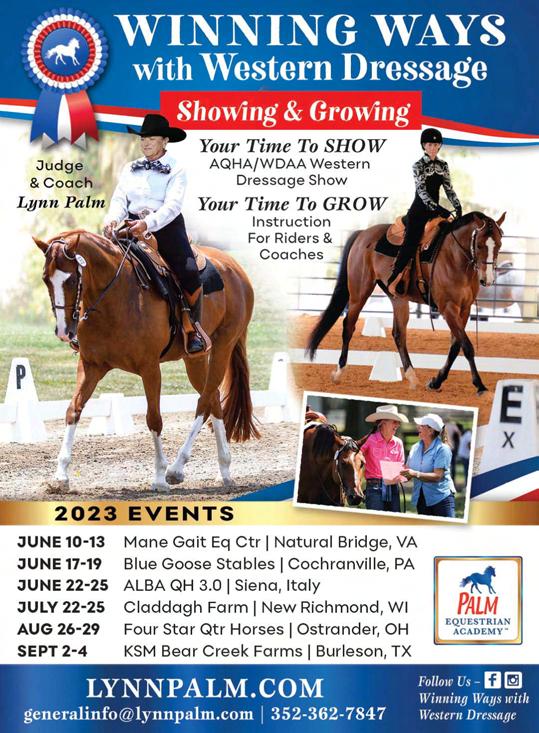


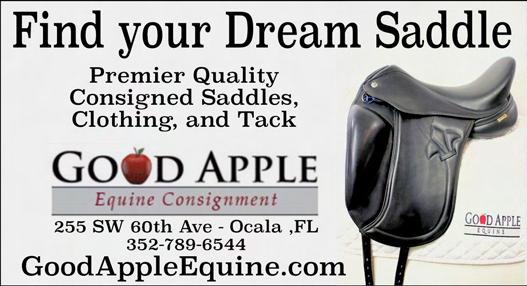


























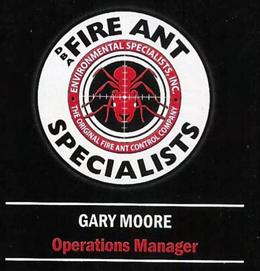


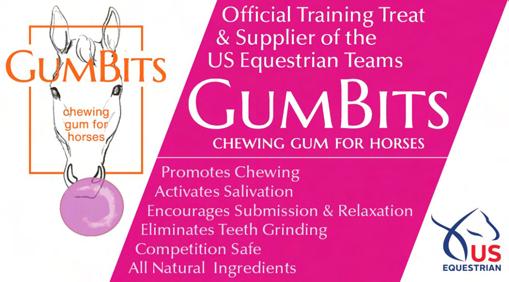




EARLY BOOKING And Multiple Mare Discounts!

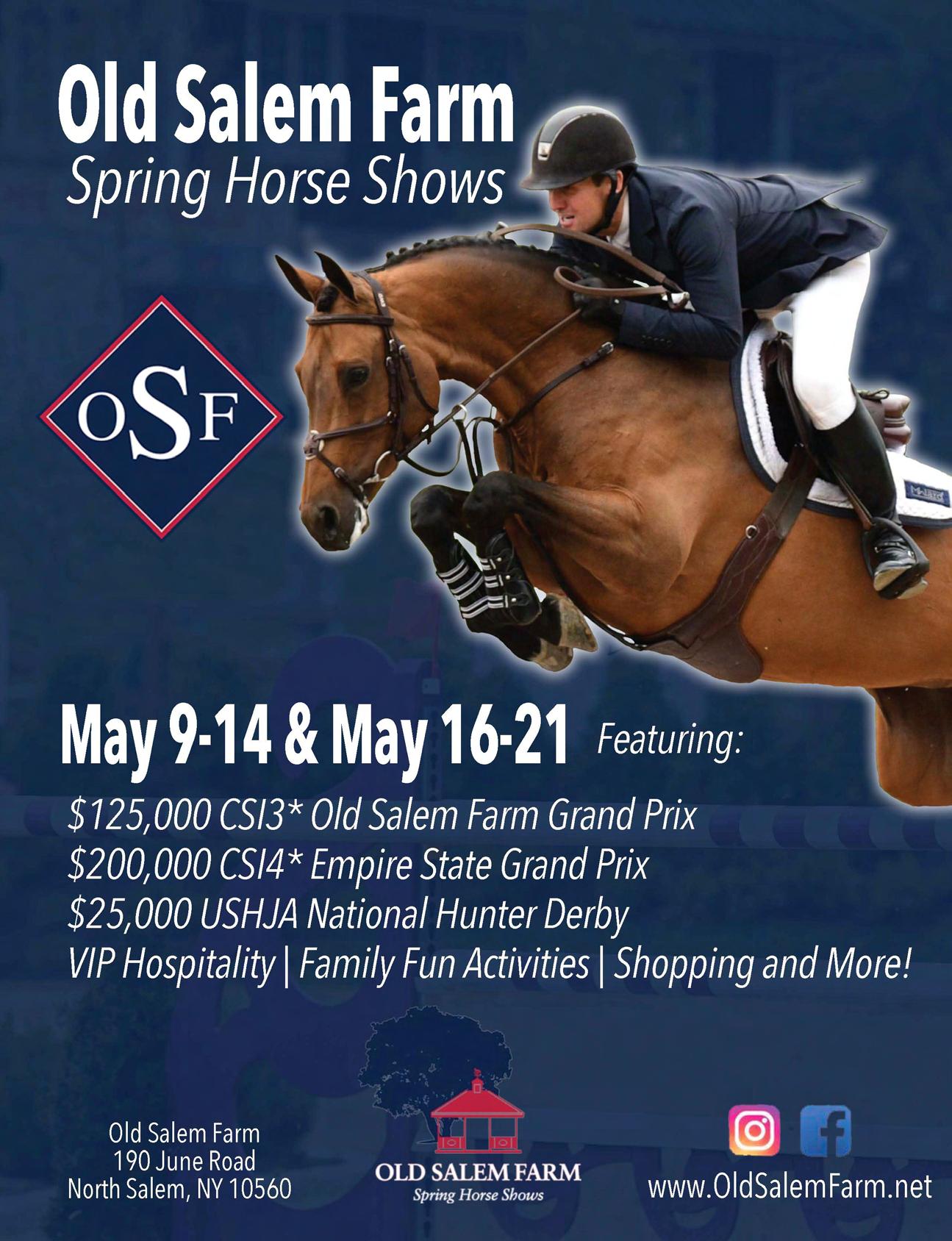






Leendert +359 89 6218130
ZALMÉ
Final Olympics Seoul 1988
Rider: Manuel Guillermo Torres
ANIMO
Final Olympics Barcelona 1992
Rider: Morten Aassen
H&M INDIANA
Breeder off the Dam
Olympics 5th place Tokio 2020
Rider: Marlin Bayard Johnson
info@olympichorses.eu
www.olympichorses.eu

